PinotFile: 8.47 December 20, 2011
|
2011 Pinot Noir All-AmericansIt has become an annual tradition to name my favorite Pinot Noir performers at the end of the year. This issue always stirs up the pot, for picking the best in any lineup of wines is always controversial. There are a number of steps I take to arrive at the wines that I most recommend in the PinotFile each year and then chose the best as All-Americans. The honored wines have all been tasted at my home in a quiet setting in the late morning and over the course of a day or two. The wines come directly from my home cellar at about 63ºF and are all tasted in identical Riedel Vinum Burgundy or Riedel Oregon Pinot Noir stemware. I usually taste 6 to 8 wines a day, giving each wine adequate time to open up in the glass and I make several passes as I taste each wine carefully. Occasionally I will decant a wine if the winemaker recommends it or if I think this will benefit the evaluation. I do not taste the wines blind, but strive for integrity, consistency and objectivity. I take my responsibility seriously. There are three reasons that I do not taste blind. First, I prefer to evaluate wines in the same manner as the consumer experiences them. Second, I believe an essential part of judging wine is to know what you are drinking. Third, I often have all the production information of the wine at hand that assists me in understanding the wine. The more background information I have, the more I am likely to discover in the wine. As Jamie Goode has pointed out, "When we are tasting blind, there is a limit to what we can say about the wine that is in front of us." I tend to focus on current drink ability, since most consumers prefer to drink their wines relatively young. I most appreciate wines that are at or close to their best the days I taste them. That said, credence is given to age ability particularly in the context of balance. I often re-taste wines later in the day with food at dinner to replicate the consumer’s drinking experience, or the next day or two from an opened and re-corked (but not gassed) bottle. The latter gives me insight into the quality, balance and age ability of the wine. I do not award scores to wines, preferring to give an unpretentious, concise, and descriptive review to reveal the style and quality of the wine that the reader can easily understand and appreciate. I am convinced that an apropos description of a wine is not only more challenging to arrive at than awarding a score, but it is the fairest way to evaluate a wine. The Pinot Geek icon is used to designate wines of exceptional merit and these wines are the only ones considered for All-American honors. The Value icon is used to indicate wines of good or better quality that are value priced (less than $35).
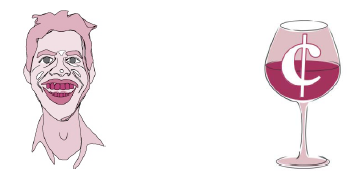 It is very challenging to single out wines from the vast array of stellar Pinot Noir currently being crafted in California and Oregon. As wine maker Daniel Baron has said, “You have to remember this when you think about judging wines. They’re alive and changing moment to moment; they have good days and bad; they show well in a particular glass or with particular food. Judging a wine at any particular moment in life is like giving a kid a letter grade based on his behavior in the supermarket.” Aromatics, flavor nuances, texture, balance, and finishing persistence all come in to play in finding those special wines that stand out from the pack. Often it is not an objective feature, but the emotion that the wine elicits that sets the wine apart. There are many technically sound wines today but All-Americans have a powerful charisma. It is a truth that it is not what is said or written about a special wine, but what is emoted that truly defines a wine’s greatness. Veronique Drouhin-Boss, the winemaker at Oregon’s Domaine Drouhin, has said it best, “There are plenty of good wines in the world that give you pleasure. A great wine gives you emotion.” Remington Norman, in his latest book, Grand Cru, notes, “The impact of great wine is as much emotional as sensorial and, in any case, at the topmost level one runs out of distinctive superlatives.” The All-Americans are judged on merit, independent of price, vintage and region of origin. I drink a fair amount of red Burgundy, but leave the critical evaluation of these wines to others more dedicated to that region. I also taste and review Chardonnay, Pinot Noir’s cool climate partner. I have no monetary arrangement with any winegrower, winery, retailer or wholesaler. I do accept wines for review but about a third of the wines I sample are bought directly from a winery or through customary retail channels. There are many Pinot Noirs that I sample casually at wineries (including barrel samples), social dinners, Pinot Noir festivals, competitive wine judging events, wine tastings and wine dinners, but I do not include these wines in the All-American selection process. Only finished, bottled wines that are formally tasted in controlled, and therefore comparable, circumstances are eligible for All-American consideration. I attempt to separate my personal Pinot Noir stylistic preferences from the objective assessment of the wines. The stylistic superiority of power versus finesse, “New World” versus “Old World,” and high alcohol versus low alcohol continues to be debated, but the inimitability of either style will in the end be decided by the consumer. The best style is the one that gives the drinker the most pleasure. I try to steer a neutral course and reward wines for their excellence regardless of “style.” It boils down to distinguishing between appreciating and liking. That said, I must admit preferring (liking) wines with under 14.2% alcohol since they are often more balanced, easier to drink, more compatible with food, allow you to drink two or three glasses without getting sideways, and confer the health benefits associated with taking in moderate amounts of alcohol. Of the wines receiving All-American awards in this issue, nearly all the wines were from the 2008 and 2009 vintages. The California Pinot Noirs ranged in alcohol percentage from 12.3 to 15.5 with 50% of the wines between 14.1 and 14.5 alcohol. In comparison, the Oregon Pinot Noirs ranged in alcohol percentage from 12.4 to 15.0 with 55% between 13.6 and 14.0 alcohol. The two charts below reflect this difference. Keep in mind that the alcohol percentages are not always “honest,” but taken from labels or tech sheets. Since a 1% reporting leeway is permissible with wines above 14.0% alcohol, the actual percentage in many cases is higher. It is noteworthy that at least one prominent wine publication (Wine Enthusiast) and one wine competition (San Francisco Chronicle Top 100 Wines of 2011) now report the alcohol percentage of their rated wines along with case production and price. I believe I was the first published wine critic to include alcohol percentage in my wine reviews, something I began doing in 2005.
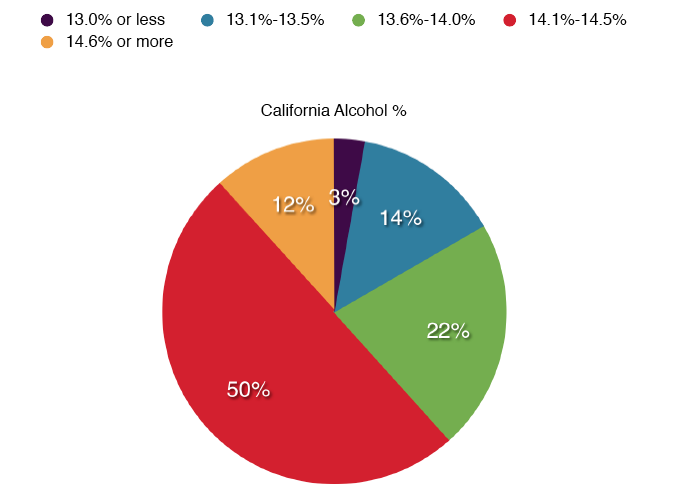
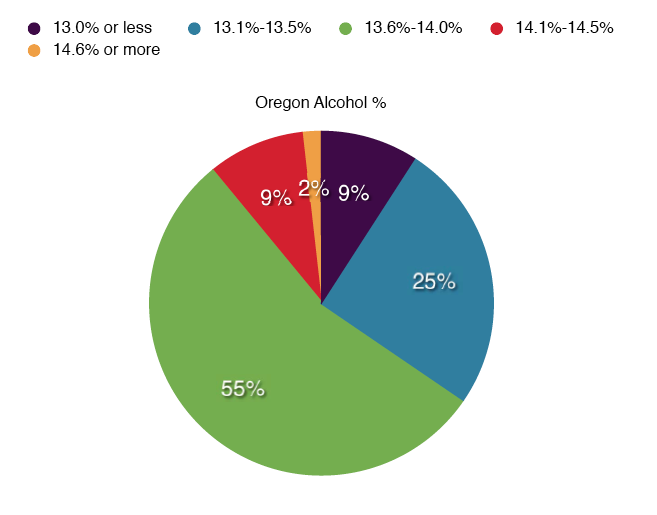 I wish to emphasize that I do not take my reviews as gospel. I always keep in mind the tenant written by noted New Zealand winemaker Neil McCallum, namely, “The difficult art of wine tasting requires a considerable measure of humility.” I preach that you use my tasting notes as a guide, but trust your own palate. Focus more on the producer than any one specific wine. The awarded wines are listed in alphabetical order or from lowest to highest price in the case of value-priced wines. Many of the wines are still available from the winery, through retail distribution or the secondary marketplace. When possible, I will indicate a source for the wine. Even though some wines are offered only to mailing list members, they may still be available and it is always worthwhile to make a phone inquiry. The reality is that the economy has posed a challenge for wineries selling wines priced above $50. A few of the most desirable wines are highly allocated, sold out, or only available through a reseller or auction marketplace. The best free wine search engines are wine-searcher.com, vinquire.com, vinopedia.com, winezap.com and wineaccess.com. If there is a Pinot Noir you just have to have and are unable to locate it, contact me and I will try to track it down for you through my connections. Keep in mind, there will always be another vintage and top producers make quality wine consistently in each vintage. The wine may not be the same song, but it will be the same composer. Membership in winery wine clubs or participation in a winery’s mailing list are good ways to insure that you obtain highly coveted Pinot Noirs from a popular producer. Current prices of awarded North American Pinot Noirs featured in this issue span the range from $5.99 to $100. Generally, quality of life with Pinot Noir begins at $20, but expect to pay at least twice this for many special wines. The 115 California Pinot Noirs awarded the Pinot Geek designation in 2011 had a price range of $28 to $100. The 35 Oregon Pinot Noirs receiving the Pinot Geek designation in 2011 ranged in price from $35 to $100. 16 wines from California and Oregon received both a Pinot Geek icon and Value icon designation ($15-$35). The California wines awarded the Value Icon ranged in price from $6 to $35 and the Oregon wines receiving the Value icon had a price range of $18 to $35. The Chardonnays awarded the Golden Geek icon ranged in price from $21 to $75. 2 California Chardonnays received both a Golden Geek icon and Value icon. Collecting and drinking Pinot Noir can be a rich man’s game if only trophy wines are sought. There are a number of cult level Pinot Noirs from California and Oregon that are priced at or above $100. Fortunately, there are many satisfying Pinot Noirs on the market that are priced less than $35. The increasing role of negociants in the production of inexpensive Pinot Noir has made these so called value-priced Pinot Noirs more available than ever. The 2011 Value Pinot Noir All-Americans represent the best $35 and under North American Pinot Noirs I sampled this year. Value Pinot Noirs do not match up in quality of fruit, aromatic sophistication, and flavor nuances compared to the more expensive prestige bottlings. You get what you pay for. I do not keep exact counts, but the number of corked wines is diminishing and is only about 1% of the wines I sample. Another 5% of wines do not appear to be corked but are just not right. I had two problems this year with corked wines I should make you aware of. In one case, I bought an older vintage of a wine from a retailer and the wine was corked. The retailer did not have a replacement and would not refund my considerable investment. When you buy older wines, you buy at your own risk. The other corked wine came from a major east coast retailer (Sherry-Lehman) and was a recent vintage. I contacted the retailer by e-mail after detecting the corked bottle, and as is often the case, the retailer wanted to pick up the bottle for verification before sending a replacement bottle. Keep this in mind when you come across a corked wine. Fortunately, for samples at least, I usually have two bottles and only report a review of the stellar bottle. I have not met with any problems with screw cap closures, but these are rare in California and Oregon on premium bottlings. Today, the number of flawed commercial wines is extremely low. You will notice that there are fewer Honorable Mention awards for Oregon Pinot Noirs compared to California Pinot Noirs. That is simply because I am based in California, travel more often to California wine regions, and taste about three times more California Pinot Noirs in an average year. This in no way represents a reflection of relative quality of Pinot Noir between the two states. There are a few awarded wines for which the reviews have not appeared in the PinotFile in 2011 but qualified for All-American consideration. This is because the wines were tasted in December, 2011, but will not be included in a newsletter write-up until 2012. Some of your favorite producers may not be mentioned because I wasn’t able to taste the wines from every California and Oregon winery that releases a Pinot Noir. For the Pinot Noirs that were left out of the awards this year, the words of Mark Twain ring true, “It is better to deserve honors and not have them, than to have them and not deserve them.”
2011 California Pinot Noir All-Americans First Team
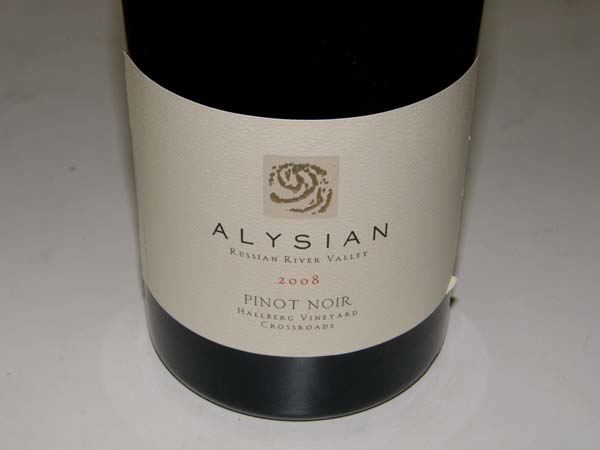 2008 Calera Wine Company Jensen Vineyard Mt. Harlan Pinot Noir 14.7% alc., 829 cases, $70. Moderately light in color with mainly reddish tones. Subdued but seductive aromas of dark red cherries and berries, charcoal and spice. Lighter in weight than the other single-vineyard Calera offerings in this vintage and unusually light for Jensen. Flavors of ripe strawberries, pie cherries and red raspberries with an appealing spice box accent, enrobed in well-proportioned dusty tannins which peak out on the dry and persistently aromatic finish. Very creamy and soft in texture. Calera’s signature Pinot Noir, deserving of all the accolades one can muster for this vintage. Available at www.calerawine.com.
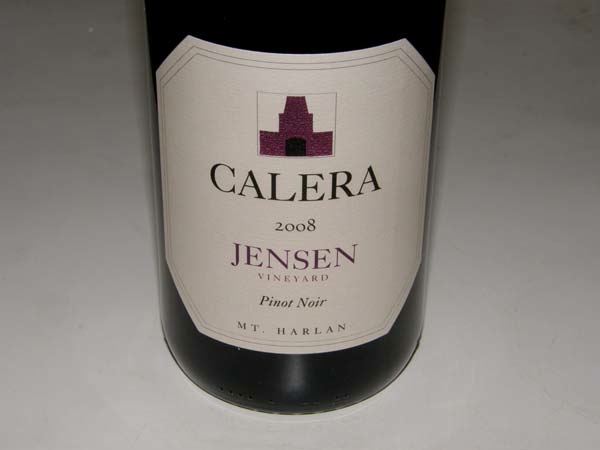 2008 Cobb Jack Hill Vineyard Sonoma Coast Pinot Noir 13.5% alc., 215 cases, $68. Demure aromas of cherry and berry fruits nicely spiced and accented by underbrush. Absolutely delicious melange of fresh cherries and berries with complimentary hints of spice, oak and minerality. Juicy, with impressive persistence on the finish. A lighter-bodied wine with gossamer tannins that has a very appealing and seductive gentleness. Available only through a mailing list that closed in 2011 (I warned you).
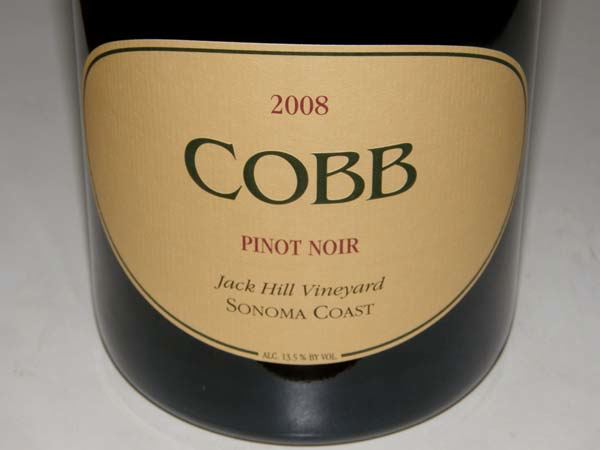 2009 Husch Nash Mill Vineyard Anderson Valley Pinot Noir 14.3% alc., 18 cases, $40. Moderately light in color in the glass. Embracing aromas of black cherries, black raspberries and woodshed picking up intensity over time in the glass. An hi-collared wine with crisp and bright flavors of dark cherries, dark red berries, cola, baking spice and Hoison sauce, wrapped in ripe, grainy tannins, finishing with an amazing persistence rarely experienced with California Pinot Noir. Beautiful interplay between fruit and tannin. Class in the glass that will thoroughly please Pinot connoisseurs. Available at www.klwines.com.
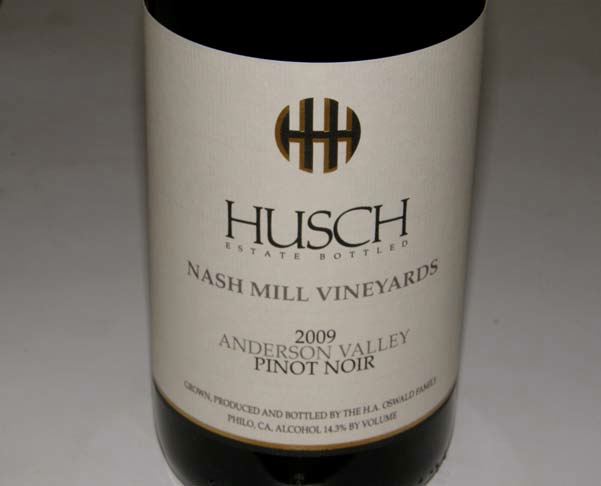 2007 J. Rochioli West Block Russian River Valley Pinot Noir 14.5% alc., $90. Moderately dark reddish-purple color in the glass. Muted aromas of dark cherries and berries, rose petals, oak cask and vanilla pod which unfold slowly in the glass. Incredible, mouth coating dark stone and berry fruit, balanced with soft, sturdy tannins, lingering appealingly on the aromatic finish. The wine is still tight, but it is clearly, evident that the fruit is perfectly ripe and the oak is properly integrated. This is an amazing, off-the-charts Pinot Noir that in five to ten years will be the star of your cellar. Figure out a way to get your hands on a few bottles of this beauty. Spectacular later in the day from a previously opened and re-corked bottle. Available through secondary marketplace only (mailing list full).
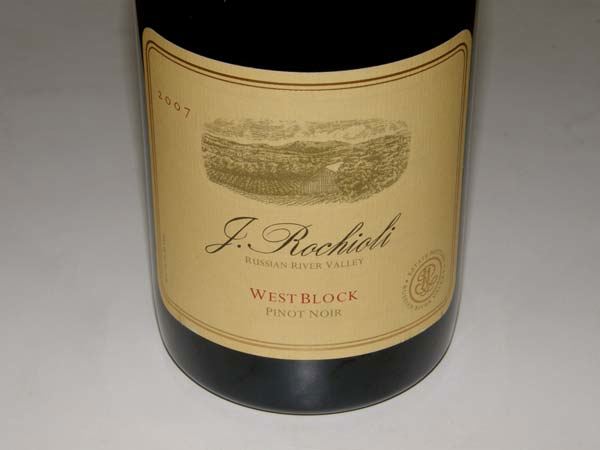 2009 Kutch Savoy Vineyard Anderson Valley Pinot Noir 13.8% alc., 264 cases, $48. Moderately dark reddish-purple color in the glass. Subdued aromas of black fruits, forest floor, vanilla and graham. A silky body of earthy, spicy boysenberry and plum brings the mid palate to attention. Beautifully balanced with lively acidity, ripe tannins and moderately rich flavors acting in harmony, capped by impressive persistence of fruit flavors on the generous finish. The pedigree of the fruit really comes through. Still great the next day from a previously opened and re-corked bottle. Will definitely benefit from a few years in the cellar, but can be approached now with decanting. A wine to contemplate. Available through secondary marketplace only (sold only through a mailing list).
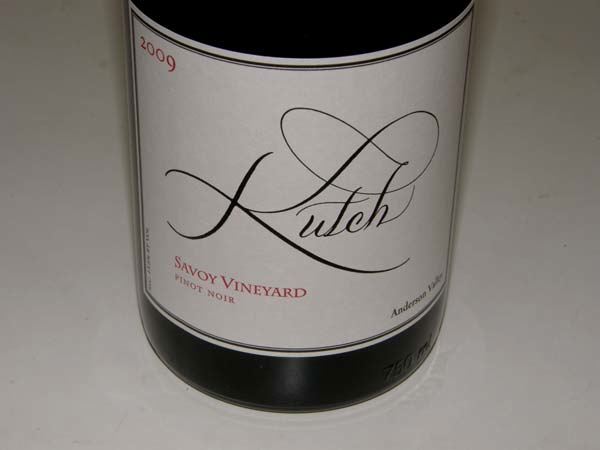 2008 Paul Lato Fiddlestix Vineyard Sta. Rita Hills Pinot Noir14.7% alc., 125 cases, $70. Gorgeous aromas of black cherries and Grandma’s fresh berry preserves with a hint of spice box including cardamom. The showy dark berry and plum fruit really sings on the palate. A man’s Pinot with plenty of sinewy tannin framing the lush fruit, but not at all foreboding. The finish has plenty of length. Softer and even more expressive the next day from a previously opened and re-corked bottle. I have three words for this wine: delicious, seductive and beguiling. Available only through a mailing list and now sold out.
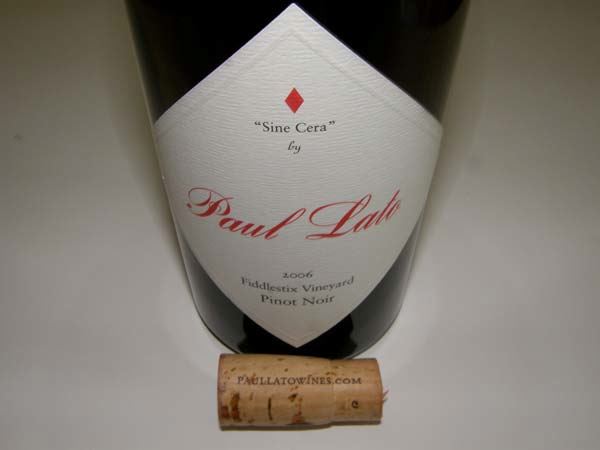 2008 Pisoni Vineyards & Winery Pisoni Estate Santa Lucia Highlands Pinot Noir 14.2% alc., $60. Moderately dark reddish-purple color in the glass. Lovely aromas of dark plums, boysenberries and sassafras with some nuanced floral and spice elements dancing in and out. Righteous juice that charms with its perfectly ripe, sappy fruit flavors and soft, silky mouth feel. Seamless with unbelievable persistence on the superbly intense finish. Descriptors cannot do this wine justice. One of the greatest California Pinot Noirs I have ever had the good fortune to drink. Available through secondary marketplace only (sold only through a mailing list and sold out).
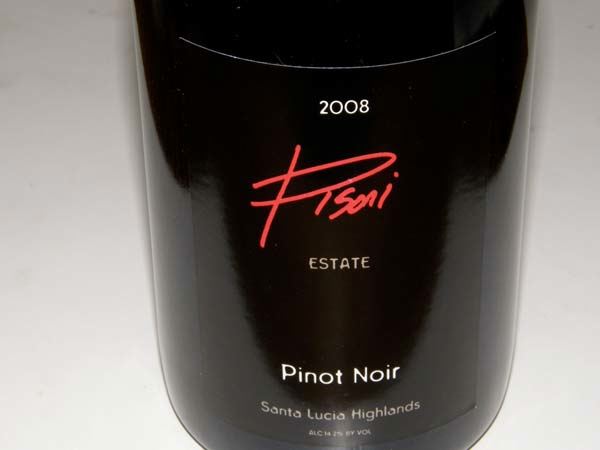 2008 Tantara Solomon Hills Vineyard Santa Maria Valley Pinot Noir 14.5% alc., 387 cases, $52. Opens slowly in the glass, seducing you gradually. Enticing aromas of dark cherries with a hint of dark chocolate and spice. Amazingly persistent on the palate and through the lengthy finish. The flavors of plum and black cherry are intense and vivid, yet the wine retains a charming, silky finesse. Even better the following day from a previously opened and re-corked bottle. Angelina Jolie in dark red velvet. Available at www.tantarawinery.com.
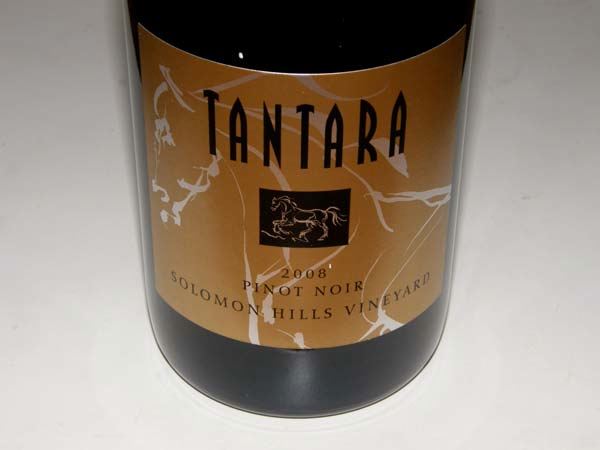 2008 Thomas George Estates Baker Ridge Backbone Block Russian River Valley Pinot Noir 14.5% alc., 60 cases, $65. Moderately deep reddish-purple color in the glass. The wine offers a bright array of aromas with staying power in the glass including scents of berry jam, spice and complimentary oak. Charming core of perfectly ripened cherry and berry fruits with a hint of brown spice set off by bright acidity and caressed by firm, but abiding tannins. Impeccable balance for the long haul. Very classy juice. Available only to winery Pioneer Club members (all eight 2008 TGE Pinot Noirs are sold out).
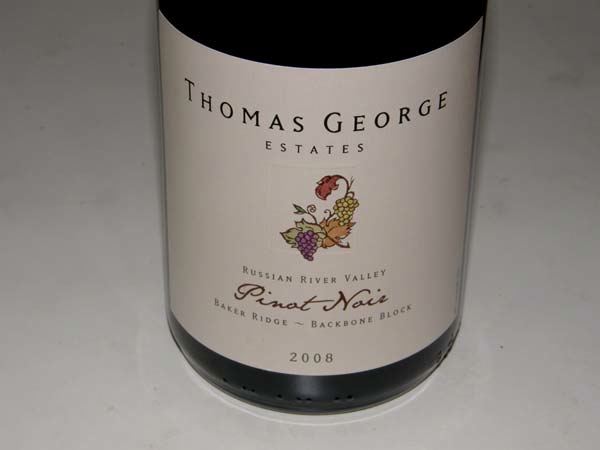 2008 Woodenhead Buena Tierra Vineyard Original Planting Russian River Valley Pinot Noir 14.2% alc., 198 cases, $60. Brooding aromas of cherries, spice and oak vanillin. Delicious fruit bombast featuring perfectly ripe flavors of black cherries and black raspberries, with notes of sassafras, cola and exotic spices. Very broad in the mouth and distinctive, leaving a lovely cherry kiss on the lingering finish. Harmonious in every way. I guarantee you're going to love this wine. Last vintage for this venerable vineyard due to phylloxera. Available at www.woodenheadwine.com.
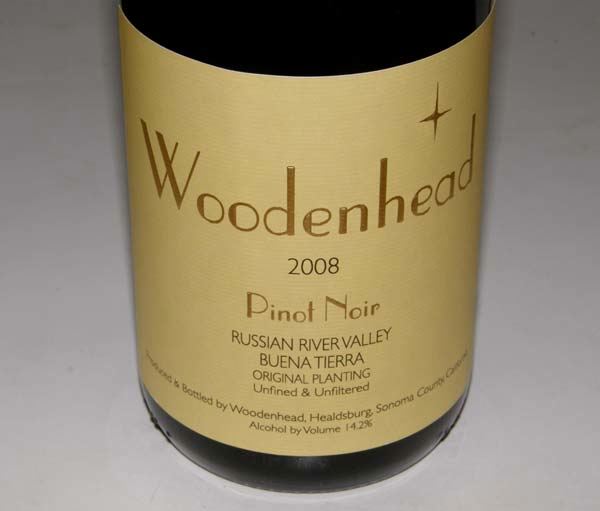
2011 California Pinot Noir All-Americans Second Team
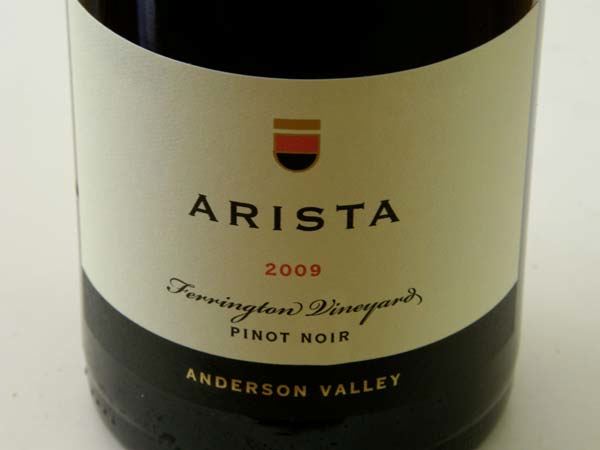 2009 Auteur Manchester Ridge Mendocino Ridge Pinot Noir 14.2% alc., 182 cases, $50. Moderately deep reddish-purple color in the glass. Demure, but seductive perfume of fresh black raspberries, black cherries, spice and vanilla wafers. Perfectly composed and seamless with delicious flavors of berries and fresh cherries accented by notes of cola, baking spices and mocha, wrapped in silky tannins. Plenty of vim and vigor with a remarkably long finish. Still great the next day from a previously opened and re-corked bottle predicting a long life ahead. I have had several stunning wines from this vineyard. Available to mailing list customers at www.auteurwines.com.
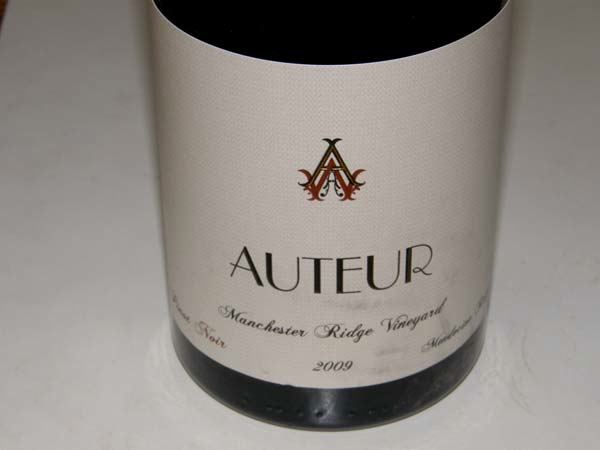 2009 Davis Family Vineyards Starr Ridge Vineyard Russian River Valley Pinot Noir 14.1% alc., 225 cases, $40. Medium ruby color in the glass. Quintessential Russian River Valley Pinot Noir sporting aromas and flavors of Bing cherries, baking spices and cola with a moderate dose of red raspberries and red currants. Still has firm tannins that will soften over time, but the wine is very enticing now. Finishes strong with impressive mouth coating intensity and a refreshing riff of acidity. A classy wine from a mature vineyard that is now coming in to its own. Available at www.davisfamilyvineyards.com.
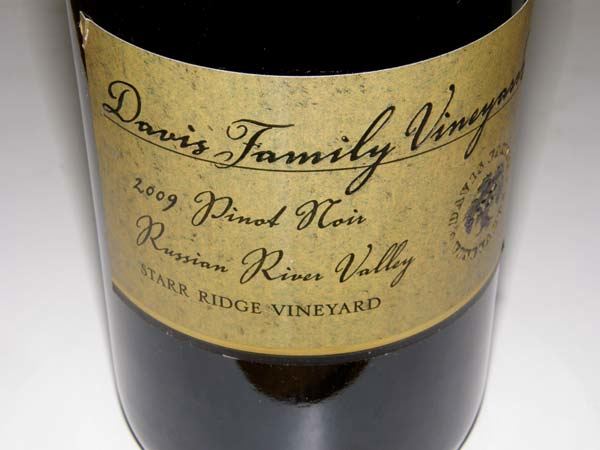 2009 Drew Weir Vineyard Yorkville Highlands Pinot Noir 13.9% alc., $40. Moderate reddish-purple color in the glass. Complex nose that unfolds slowly revealing many nuances including aromas of dark berries and black plums, mushrooms, bramble, spice and rose petal. Delicious core of fresh plum compote wrapped in firm, but well-honed tannins, attacking the mid palate with conviction, and persisting on the soft finish that shows a riff of citrus and a perfume of plum sauce. Deft balance between richness, acidity and tannin. It is wines like this that make Pinot my paramour. Available through New Release Club; recently released so inquire at 707-877-1771.
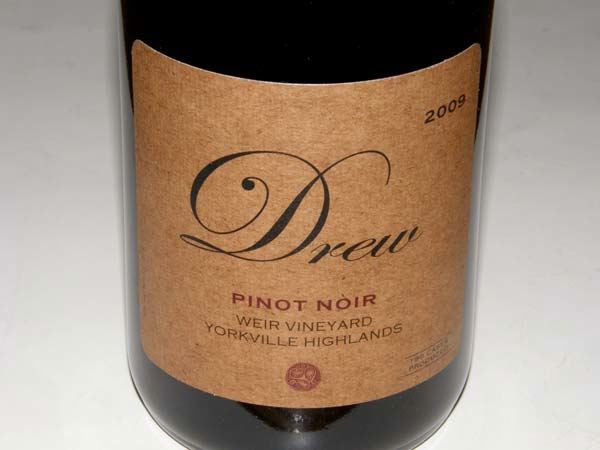 2009 DuMOL Russian River Valley Pinot Noir 14.3% alc., 3,900 cases, $64. This wine was a revelation. Moderately deep reddish-purple color in the glass. Lovely, demure aromas of dark red cherries and berries and brioche. Sinfully delicious with intense, sweet flavors of black cherries, spice and Hoison sauce. Polished and classy, seductively silky on the palate, with suede tannins and perfect integration of oak, ending with a juicy finish that lures you back to the glass. Impeccable balance. One of the highest priced Russian River Valley appellation wines, but everything you could ask for, and worth every penny. Available through a mailing list (pre release members) at www.dumol.com with limited retail and restaurant distribution.
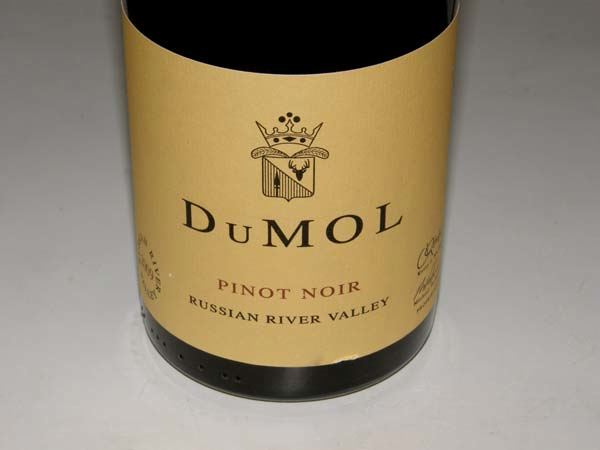 2009 Eric Kent Small Town Sonoma Coast Pinot Noir 13.7% alc., 288 cases, $45. Moderately light reddish-purple hue in the glass. Shy but very pleasant perfume of dark red berries, black cherries, Asian spice and cola, becoming more expressive in the glass over time. Vigorous with dark red fruit flavor, complimented by notes of sassafras and spice including clove. Possessing plenty of character with svelte tannins and welcoming acidity on the generous finish. Really spectacular two days later from a previously opened and re-corked bottle. Best Pinot ever from winemaker Kent Humphries. Available through a mailing list at www.erickentwines.com, currently sold out.
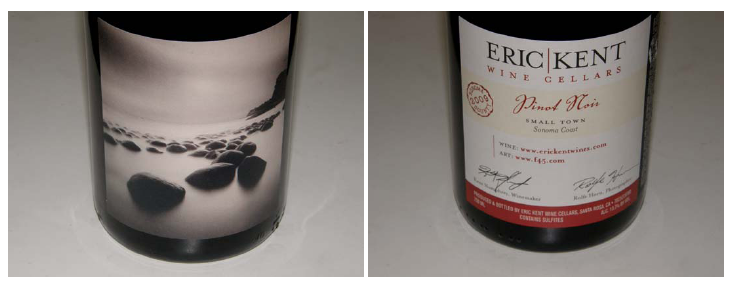 2009 Freestone Vineyards Estate Grown Sonoma Coast Pinot Noir 13.5% alc., 4,660 cases, $55. Moderately deep reddish-purple color in the glass. Subdued nose initially, picking up intensity over time in the glass, offering a fresh blend of cherries and berries with a floral element in the background. Very impressive concentration, even sappy on the mid palate, with generous and expressive flavors of black cherries, black raspberries and Hoison sauce, lifted by hi-tone acidity, and caressed by gentle, ripe tannins. An impressive hedonistic style of wine with the right touch of acidity, a creamy mouth feel and admirable balance. Good approachability now but has excellent aging potential. Available at www.freestonevineyards.com.
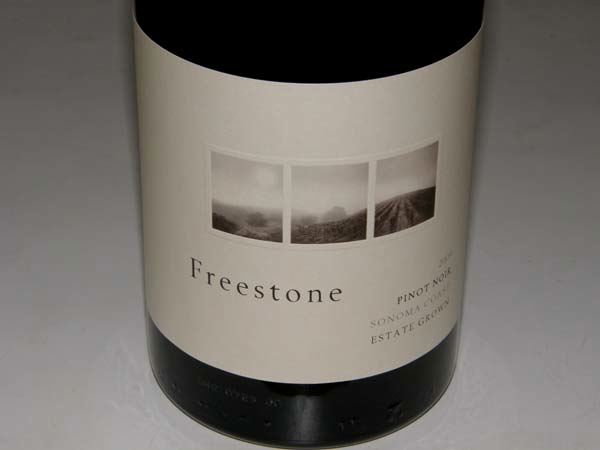 2009 Kosta Browne Garys’ Vineyard Santa Lucia Highlands Pinot Noir 14.7% alc., 439 cases, $72. Dark and dense reddish-purple color in the glass. Reserved but pleasing aromas of black stone fruits with complimentary oak spice and anise. Rich, full, sweet and beautifully composed black plum and blackberry flavors that offer real density and a mouth coating finish of unbelievable persistence. Fruit-driven and primary now, but the gorgeous fruit is impossible to ignore. I have never tasted anything so sensual from this vineyard. Wowzaa! Available through the secondary marketplace; sold out at the winery via mailing list at www.kostabrowne.com.
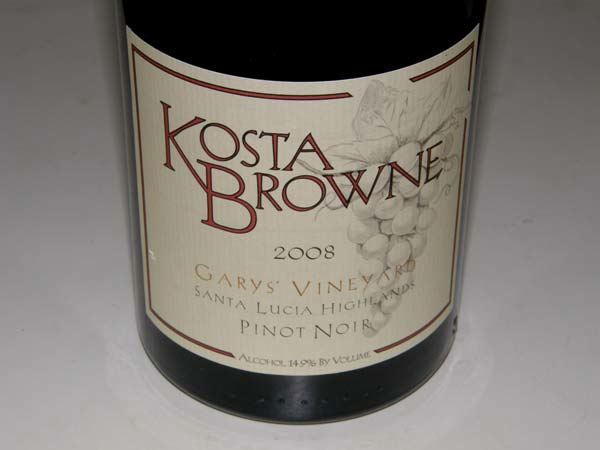 2008 Rhys Vineyards Swan Terrace Alpine Vineyard Santa Cruz Mountains Pinot Noir 13.0% alc., $69. Moderately dark reddish-purple color in the glass. With intense swirling, an appealing scent of mixed berry preserves, crushed black grapes, and a hint of floral perfume emerges. The wine offers well-endowed flavors of plum sauce and dark red raspberries, cola and grilled meat. Rather linear now with the fruit buried in flamboyant tannins. There is an earth and mineral infused quality to the fruit which is appealing and I sense that this wine will perform beautifully in another five years. The wine benefited from re-corking the bottle and sampling it the next day. A connoisseur’s wine with unlimited potential. Available only to mailing list customers at www.rhysvineyards.com.
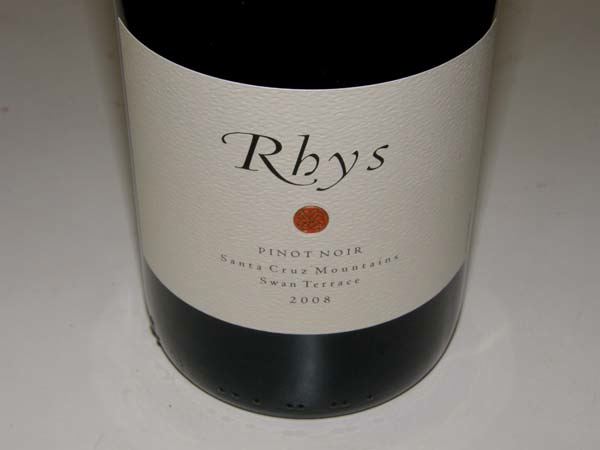 2009 Siduri Garys’ Vineyard Santa Lucia Highlands Pinot Noir 14.2% alc., 298 cases, $50. Enticing aromas of black cherries, deeply colored berries and cola. A lip smacker with oodles of fruit that saturates the palate and persists on the finish with a clinging vengeance. Soft and smoothly textured with relaxed tannins. This is a kick-ass Pinot that will bring you to your knees. Available to mailing list customers at www.siduri.com with limited retail distribution.
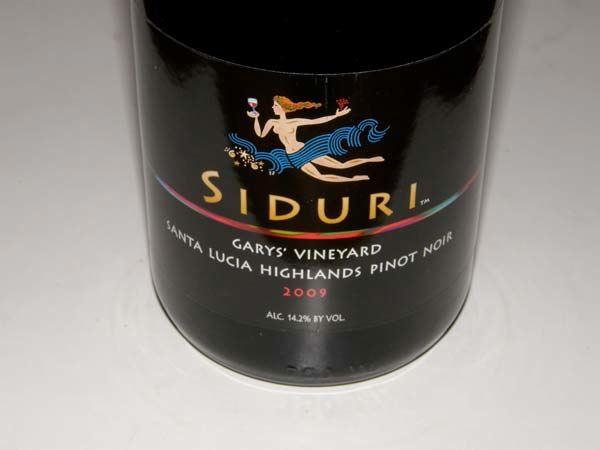 2008 Windy Oaks Limited Release 100% Whole Cluster Santa Cruz Mountains Pinot Noir 13.9% alc., 173 cases, $55. Moderately light reddish-purple color in the glass. Remarkably effusive aromas of black cherries, vanilla, musk and spice. Delicious essence of fresh black cherry pie with subtle notes of baking spices, cola and oak. Almost creamy, with moderate fine-grain tannins. Discreetly rich and fully ripe fruit with a striking note of cherry on the finish. The whole cluster fermentation confers a seductive mouth feel and a charming spice note. Very special.
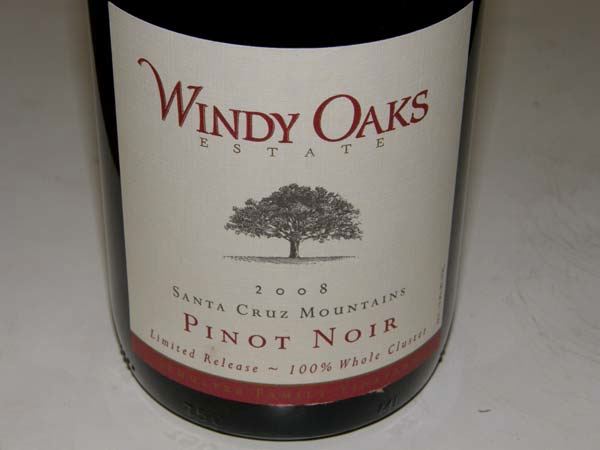
2011 California Pinot Noir All-Americans Honorable Mention
2009 Kosta Browne 4-Barrel Mendocino County
2009 Anthill Farms Comptche Ridge Vineyard
Mendocino Ridge
2009 Arista Perli Vineyard
Anderson Valley
2009 Anthill Farms Demuth Vineyard
Sonoma Coast
2008 Bjørnstad Hellenthal Vineyard
Russian River Valley
2008 Alysian Starr Ridge Vineyard East Terrace
Cole Ranch 2009 Esterlina Cole Ranch Reserve Sonoma Mountain
2009 Bailiwick Silver Pines Vineyard
Carneros
2008 Campesino Cellars Papi y Chula Vineyard
Santa Cruz Mountains
2009 Mount Eden Estate
Santa Lucia Highlands
2009 Kosta Browne Garys’ Vineyard
Mt. Harlan 2008 Calera Mills Vineyard Santa Maria Valley & San Luis Obispo County
2005 Arcadian Dierberg Vineyard
Sta. Rita Hills
2005 Arcadian Fiddlestix Vineyard
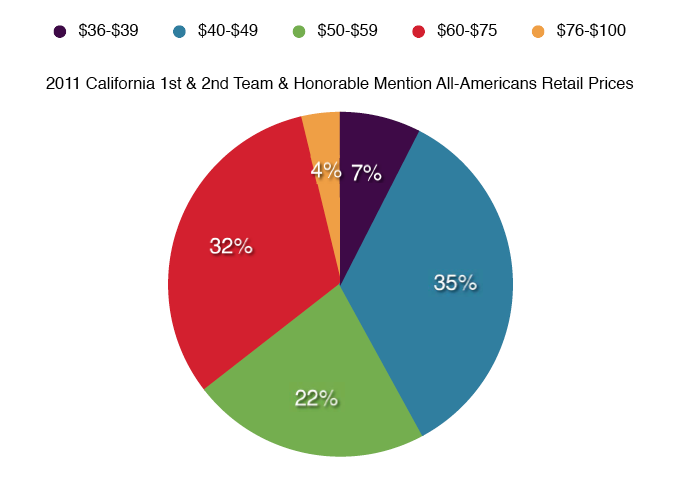 The chart above indicates that 42% of the wines were priced between $36 and $49, and 58% were priced between $50 and $100.
2011 California Value Priced Pinot Noir All-Americans
• 2010 Ellipsis Wine Co Russian River Valley Rosé $15
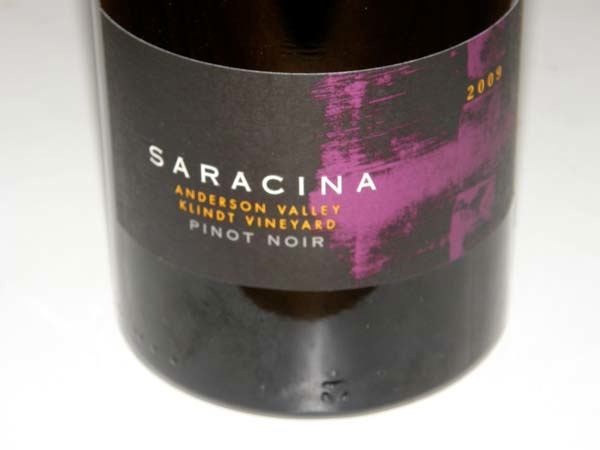 Many of the following wines are widely distributed in wine retail and supermarket stores and most are currently available. They are often discounted below the listed prices. Pinot Noirs priced at $60 and more have been decried as the “dead zone” because the poor economy in recent years has made it difficult to sell wines in this price category. The wines below, however, can be considered to be in the “fun zone,” and scoring these wines can make you feel good about skirting a punishing economy.
2009 Redtree California $5.99
2011 Oregon Pinot Noir All-Americans First Team
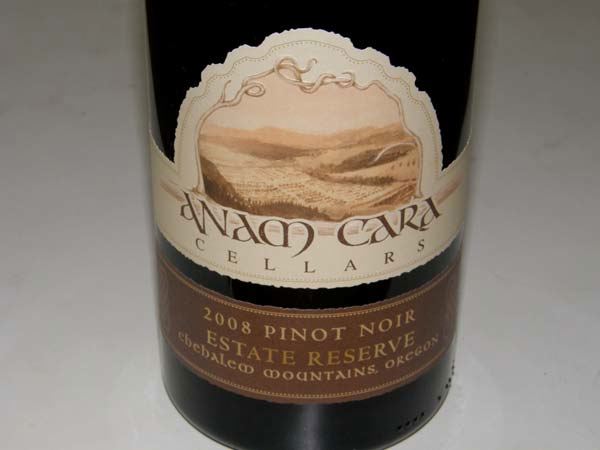 2009 Antica Terra Estate Grown Eola-Amity Hills Willamette Valley Pinot Noir 13.6% alc., $100. Moderately dark reddish-purple color in the glass. An engaging Pinot Noir with a gorgeous perfume of wild berries, Christmas spices, mesquite, underbrush and coffee. The allure carries through on the palate with layers of flavorful dark berries, savory additions of leaf and spice, an exotic note of musk, and a complimentary underpinning of smoky oak. Impeccably balanced and very sensual in the mouth. A beautiful food wine that was even better the next day from a previously opened and re-corked bottle. If this Pinot were a lover instead of a wine, it’s one that would make you leave your family, abandon your job, and forfeit your hard-won respect in the community for just one more fling. Available through the winery mailing list at www.antica-terra.com.
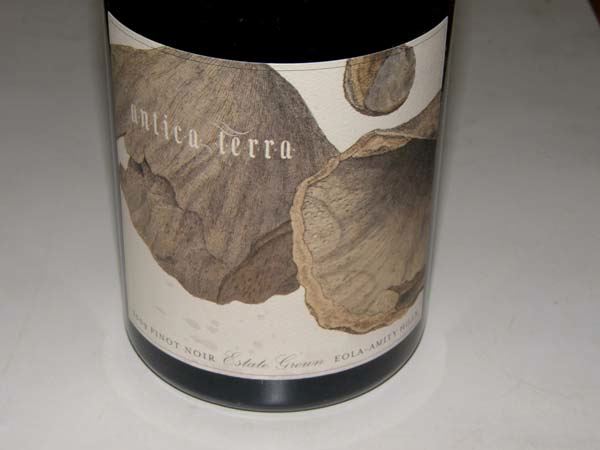 2008 Beaux Frères The Beaux Frères Vineyard Ribbon Ridge Willamette Valley Pinot Noir 13.6% alc., $80. Moderately light in color with a red tone. The aromatics are relatively closed, revealing more toasty oak than fruit. The wine offers much more on the elegant palate, with discreetly rich and pleasing flavors of strawberries, cherries and oak accents that linger on the juicy finish. Well-integrated acidity and tannins offer a harmony that predicts 10+ years of longevity. Stunning the next day from a previously opened and re-corked bottle indicating the wine needs cellaring. There is nothing like older vine fruit. Available at www.beauxfreres.com.
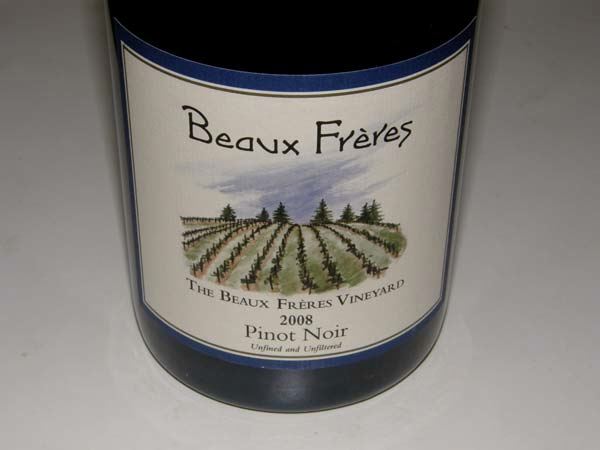 2009 Coelho Winery Paciência Estate Willamette Valley Pinot Noir 13.0% alc., 525 cases, $40. Moderate reddish-purple color in the glass. Bombastic aromas of black cherries, spice, seasoned oak, brier and rose petal. Stunning black cherry and black raspberry liquor-like flavor. Palate-staining, yet discreetly concentrated and light on its feet, finishing with large scale fruit flavors that last for a minute. Hints of allspice, oak and tar in the background. Still great the next day from a previously opened and re-corked bottle. An instant festive occasion. Available at retailer Total Wine; sold out at the winery.
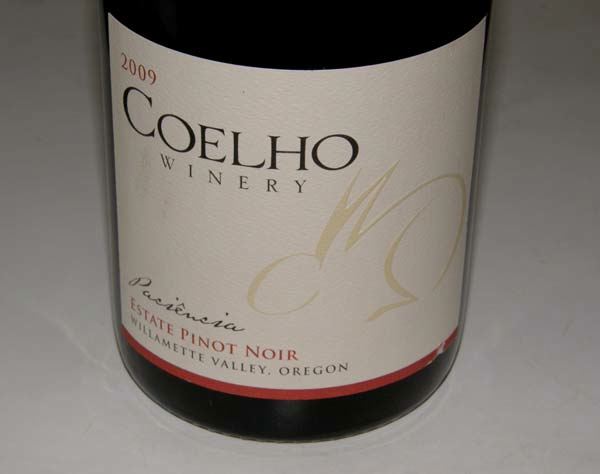 2008 Cristom Eileen Vineyard Eola-Amity Hills Willamette Valley Pinot Noir 14.0% alc., 659 cases, $50. Moderately dark reddish-purple color in the glass. Subdued and mysterious perfume of black fruits, spice and stem. Fresh and juicy on the palate with very impressive extraction and a prodigious tannic backbone. The flavors of fresh blackberries, Hoison sauce and Asian 5-spice are reserved and take a back seat to the tannins at present. Still, there is amazing Grand Cru persistence on the huge finish. Tremendous potential here, but will take years to fulfill. Available from the winery at www.cristom.com and select wine retailers.
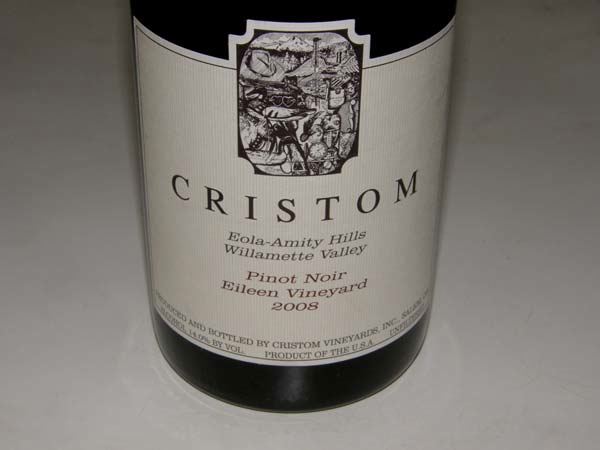 2008 Domaine Drouhin Laurène Dundee Hills Willamette Valley Pinot Noir 13.9% alc., $65. Moderately light reddish-purple color in the glass. The fruit aromas have not completely arrived in the wine, so the scent of dark red cherries and berries is overshadowed by oak. Bright and lively flavors of black cherries, black raspberries, cola and sassafras led by oak undertones that are prominent at this immature stage. A serious, polished wine that is moderately intense and structured, yet displays an admirable elegance, finishing with remarkable length. You could drink a bottle now, but it would be a crime as the wine needs several years to emerge and shed its oak wrap. Drink the superb and more approachable 2008 Domaine Drouhin Willamette Valley bottling while you wait for the Laurène to mature. Available at the winery at www.domainedrouhin.com and from select wine retailers nationally.
 2009 Laura Volkman Rachel Estate Chehalem Mountains Willamette Valley Pinot Noir 13.7% alc., 125 cases, $50. Moderate reddish-purple color in the glass. I had to look up some superlatives for this one. The perfume reminds me of the early summer first crop of fresh berries covered in vanilla pastry creme. Silky and elegant on the palate with well-mannered fine-grain tannins and intensely flavored core of black cherries, raspberries, sandalwood, vanillin, herbs and spice brought into focus by a good cut of acidity. The most appropriate superlative I could find was “heavenly.” Available from the winery at www.volkmanvineyards.com and retailer www.northwest-wine.com.
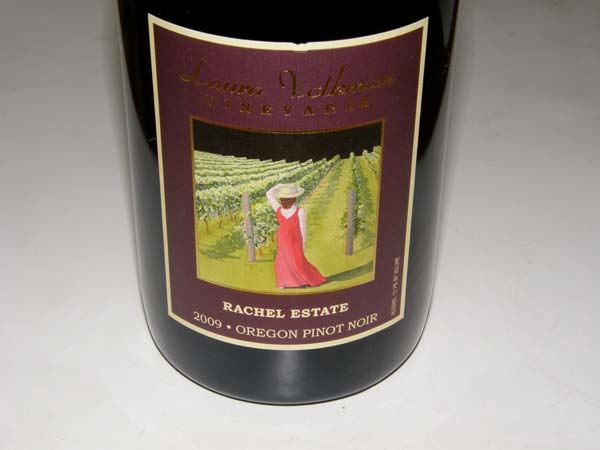 2008 Soter Vineyards Mineral Springs Yamhill-Carlton District Willamette Valley Pinot Noir 13.8% alc., $40. Moderate reddish-purple hue in the glass. Terrific nose with bright aromas of ripe berries, forest floor and good barnyard. Remarkably flavored in the mouth with a depth and richness of cherry and berry flavor that defies description. Soft and elegant with well-proportioned tannin and acidity. One of the best 2008 Oregon Pinot Noirs I have tasted and a superb cellar candidate. Available from fine wine retailers. The winery has the white label Mineral Springs Pinot Noir ($85) available at www.sotervineyards.com.
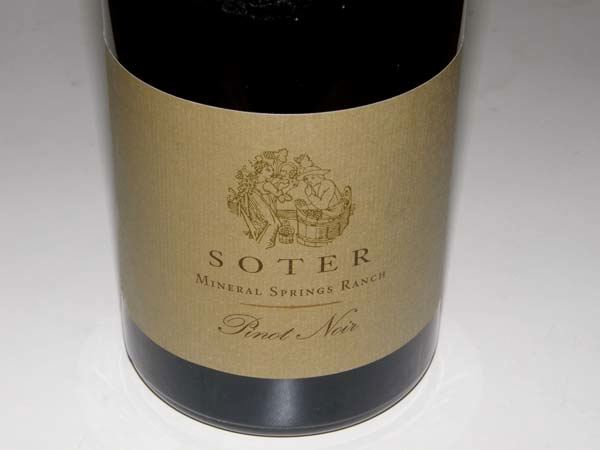 2009 The Eyrie Vineyards Original Vines Reserve Dundee Hills Willamette Valley Pinot Noir 13.5% alc., $60. Moderately light reddish-purple hue in the glass. Enticing aromas of strawberries, raspberries and melon. Perfectly balanced with a charming array of Pinot fruits showing more restraint than the Estate bottling, but offering more long-term potential. The epitome of the “Eyrie style,” with a sexy silkiness, elegance and a touch of terroir-driven dried herbs on the finish. Showing a little oak vanillin now due to its young age. The harmony and breeding of this wine predicts a long cellar life ahead. An Oregon classic Available from the winery at www.eyrievineyards.com.
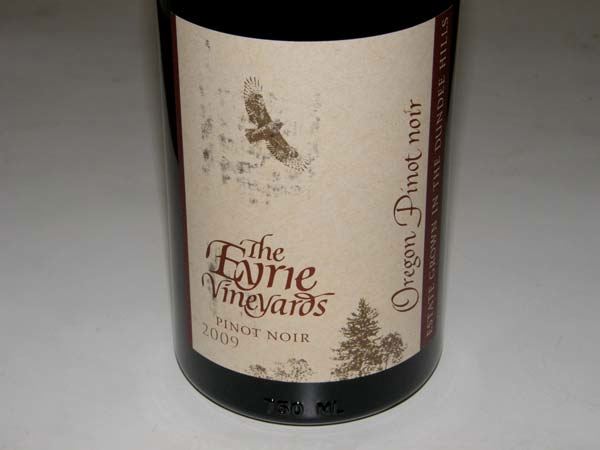 2008 Tyee Wine Cellars Estate Barrel Select Willamette Valley Pinot Noir13.5% alc., 100 cases, $35. Moderately light reddish-purple color in the glass. Reserved but pleasing scent of fresh cherries and raspberries with a hint of spice and rose petal. Similar flavor profile to the Estate bottling but with more intensity, more persistence, and more sophistication. The perfectly ripened fruit has a dark red profile, the dry tannins and crisp acidity frame the fruit beautifully, and the silky finish makes a lasting impression. A perfect argument for the superiority of old vine Pinot Noir. The wine was still great the following day from a previously opened and re-corked bottle, but I couldn’t report beyond this as I eagerly finished the bottle. An exceptional wine that is much more approachable than many reserve Pinot Noirs from Oregon’s 2008 vintage. A vin de garde for Oregon in 2008. Remarkably, still available from the winery at www.tyeewine.com.
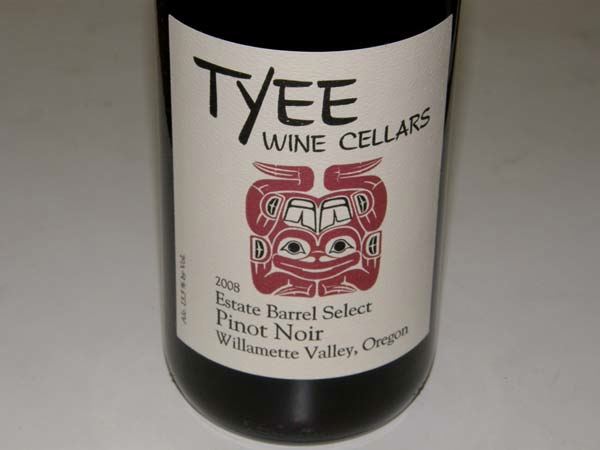 2009 White Rose Estate White Rose Vineyard Dundee Hills Willamette Valley Pinot Noir 13.8% alc., 308 cases, $70. Moderately light reddish-purple color in the glass. Glorious nose offering aromas of cherry pie just out of the oven, baking spice, and potpourri. The palate is long and elegant, featuring waves of dark cherries and magic spice with well-mannered dusty tannins and perfectly matched acidity. Spectacular the next day from a previously opened and re-corked bottle. A very classy wine that speaks of low yields and old vine fruit and is a more than worthy successor to the wonderful 2008 vintage bottling of this wine. Available to winery wine club members at www.whiterosewines.com.
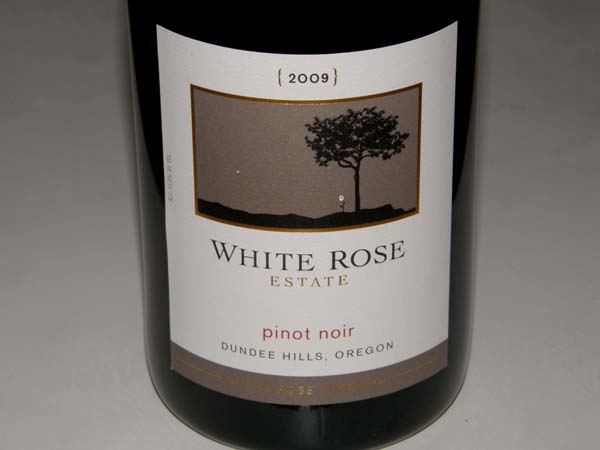
2011 Oregon Pinot Noir All-Americans Second Team
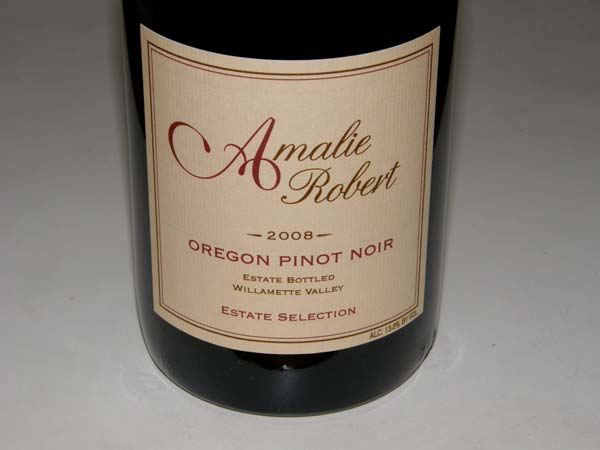 2008 Argyle Nuthouse Reserve Series Eola-Amity Hills Willamette Valley Pinot Noir 14.0% alc., 3,200 cases, $42. The nose is reserved, offering delicate aromas of dark stone fruits and berries with complimentary oak. Vivid and intense red and black berry compote on the palate including a striking attack of black raspberry fruit on entry that lingers on the finish. Well-rounded, smoothly textured, with a lively acid underbelly. More approachable than the 2008 Argyle Reserve, but this wine will also benefit from cellaring. Do not overlook this well-priced beauty from a great vintage. Available through the winery’s website at www.argylewinery.com and select retail stores.
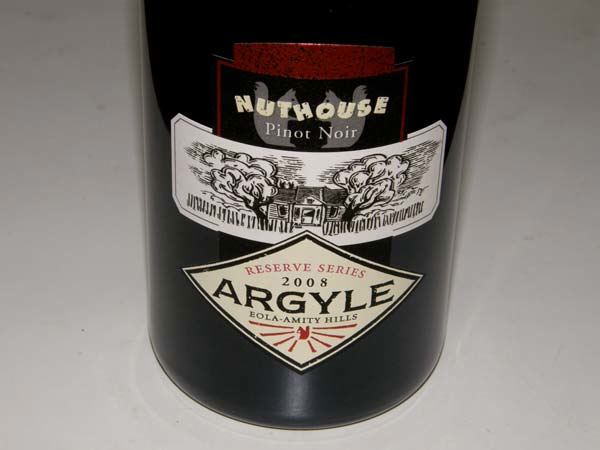 2009 Bergström Shea Vineyard Yamhill-Carlton District Willamette Valley Pinot Noir 14.1% alc., $46. Moderately intense reddish-purple color in the glass. Complex perfume exhibiting scents of purple fruits, spice, cigar box and toast. A medium weight, tasty wine that offers layers of flavor including fresh plums, blackberries and Hoison sauce. The wine flows smoothly over the palate and lingers on the finish for what seems like 60 seconds. The wine displays hearty tannins now, but they are well balanced by the fruit and acidity. Shea Vineyard performed beautifully in this vintage and Bergström showcased this iconic fruit source beautifully. This wine will have many fans. Available through fine wine retail stores (the 2010 vintage is now offered at the winery at www.bergstromwines.com).
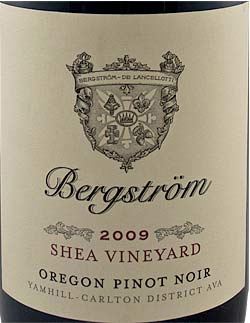 2008 Daedalus Cellars Maresh Vineyard Dundee Hills Willamette Valley Pinot Noir 12.4% alc., 24 cases, $60. Lighter redder-toned color in the glass. Intense aromas of dark red cherries and berries with oak in the background. Impressive mid palate flavors of ripe red cherries and berries with complimentary oak spice and toast. Seamless, sophisticated and classy with a capital C. Very light on its feet and elegant in style. Will be better over time as the oak integrates, but hard to resist now. Nothing like Pinot Noir from old vine fruit. Available from the winery at www.daedaluscellars.com.
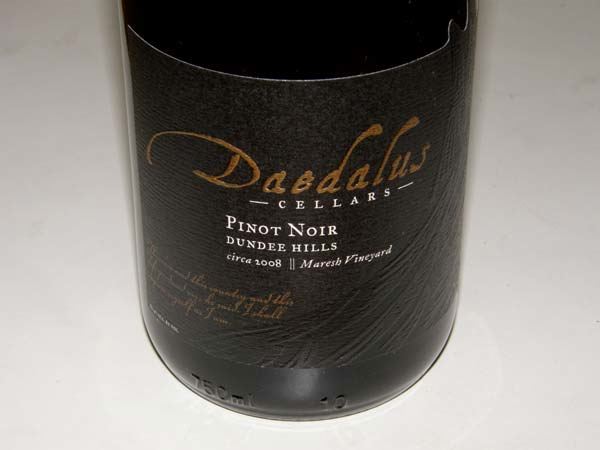 2009 De Ponte Cellars Dundee Hills Willamette Valley Pinot Noir 14.1% alc., 1,881 cases, $38. Full-on perfume of fresh boysenberries, potpourri, incense and Moroccan spices. Lip smacking black cherry and boysenberry essence with subtle oak, musk and spice undertones. Everything you want in a Pinot Noir: mouthwatering attack, bright acidity, ripe tannins, a lingering finish and impeccable balance. A stylish and sensual pleasure. Available through the winery’s website at www.depontecellars.com.
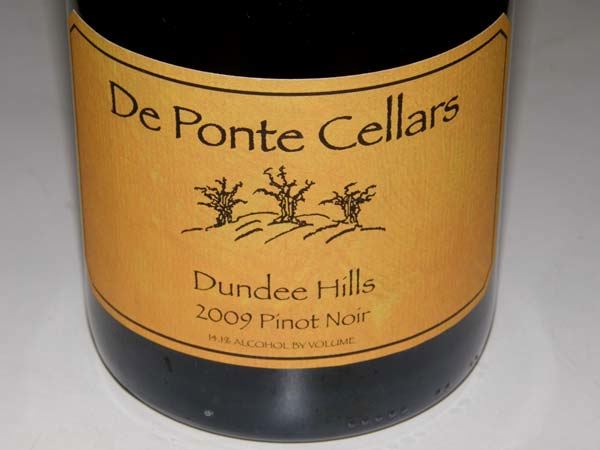 2009 Et Fille Maresh Vineyard Dundee Hills Willamette Valley Pinot Noir 13.8% alc., 103 cases, $42. Moderately light reddish-purple hue in the glass. Demure, but pleasing perfume of red and black berries, with hints of smoky oak and tobacco. A young, but sophisticated wine, with a stunning array of black cherry, red currant and red plum flavors robed in chewy tannins. The pedigree of the fruit is obvious. A powerhouse that is impenetrable now, still showing some unintegrated oak, and not ready for prime time. Like a new pair of Christian Louboutin shoes: able to attract plenty of attention. Available through the winery at www.etfille.com.
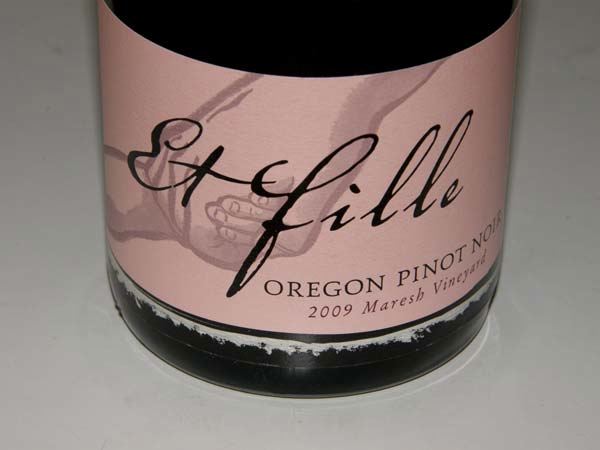 2008 Lange Estate Vineyards & Winery Freedom Hill Vineyard 13.5% alc., 250 cases, $60. Tasted in August 2010 and re-tasted recently in late 2011. Moderately dark reddish-purple color in the glass. Welcoming aromas of black plums, dark cherries, cassis, forest floor and damp earth. Soil-inflected core of intensely flavored black plum fruit that is beginning to shed its baby fat. Since last tasted the tannins have become softer, the oak has faded into the background, and the wine is exhibiting an amazingly long finish that has a bright cut of acidity. The wine has the balance for long-term aging. Put on your big boy pants when you open this one. Available only through the secondary marketplace. The winery is currently offering the 2009 version at www.langewinery.com.
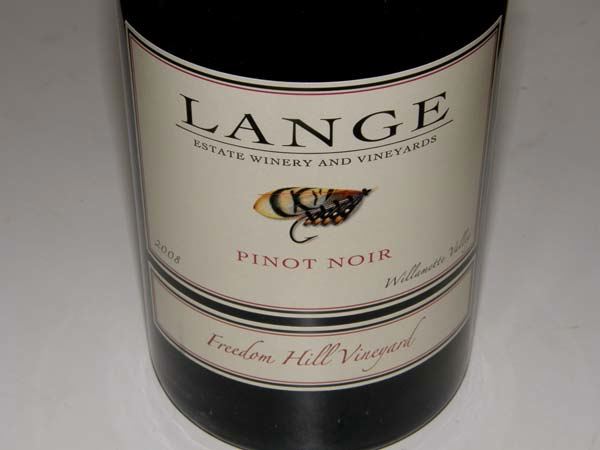 2008 Ponzi Vineyards Aurora Vineyard Willamette Valley Pinot Noir 13.5% alc., 50 cases, $100. Moderately dark garnet color in the glass. Demure scents of dark red fruits, polished woods and brioche. Intense and mouth coating flavors of dark red cherries and raspberries, with a citrus note in the background. The massive fruit is largely buried in substantial tannins and the wine is not offering the whole package at this time. Much better two days later from a previously opened and re-corked bottle. A little more showy than the companion Abetina Vineyard bottling. Cellar for at least 3 to 5 years and then open the wine on a special occasion. Available only through the secondary marketplace; sold out at the winery.
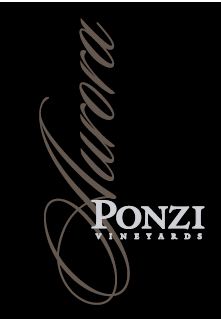 2008 ROCO Private Stash Chehalem Mountains Willamette Valley Pinot Noir 13.5% alc., $75. Moderately light reddish-purple hue in the glass. The nose is closed for business initially, opening up over time in the glass to reveal hi-tone aromas of red Pinot fruits and spice box. Pleasing middle weight dark red cherry and berry flavors with a hint of candied spice and Red Vines. The taste profile is more typical of Pinot Noir from the Dundee Hills. A classy wine with admirable elegance that is very smooth in the mouth and literally grows on you over time. Will benefit from decanting. Available from the winery at www.rocowinery.com.
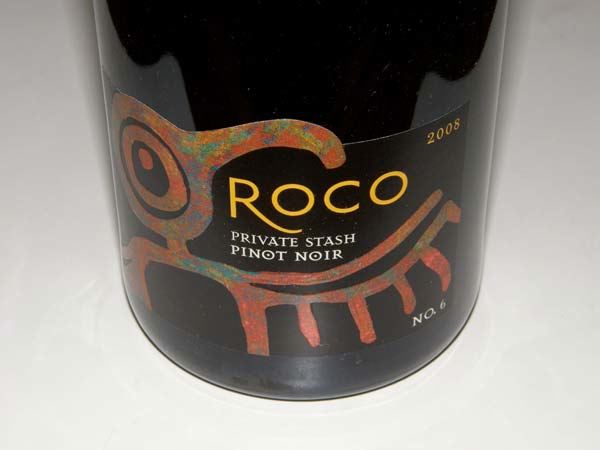 2009 Roots Estate Vineyard Yamhill-Carlton District Willamette Valley Pinot Noir 13.9% alc., $29. Moderately light in color in the glass. Nicely perfumed with intense aromas of fresh cherry tart, pie spice and cardamom. The wine sports a delicious core of cherries set off by underpinnings of sassafras, baking spice and vanilla. Light, elegant and silky on the palate, with supple fine-grain tannins, and a refreshingly tart finish offering a hint of orange peel. Interesting interplay between the slightly grainy tannins and fresh fruit. This is far from a blockbuster, but hits all the right notes and offers immense pleasure. Still solid the next day from a previously opened and re-corked bottle. Available from the winery at www.rootswine.com and through limited retail channels such as www.winex.com and www.northwest-wine.com.
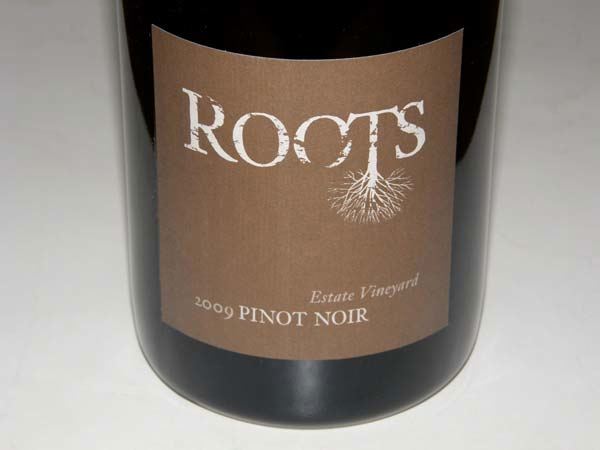 2009 White Rose Estate Whole Cluster White Rose Vineyard Dundee Hills Willamette Valley Pinot Noir 14.0% alc., 124 cases, $90. Moderately light reddish-purple hue in the glass. This wine really grabs your attention with a festival of ripe and forward aromas and flavors including dark pie cherries and magic spice. Upon entry, the wine jolts your taste buds to action, offering substantial pleasure while displaying a seductive charm that carries over to the long and silky, cherry-soaked finish. Still mildly reserved, this marvelous juice should improve effortlessly over the next three to five years, and drink well for another five to ten years beyond that. Pick any superlatives you wish; my choice is “libidinous.” Available to wine club members at www.whiteroseestate.com.
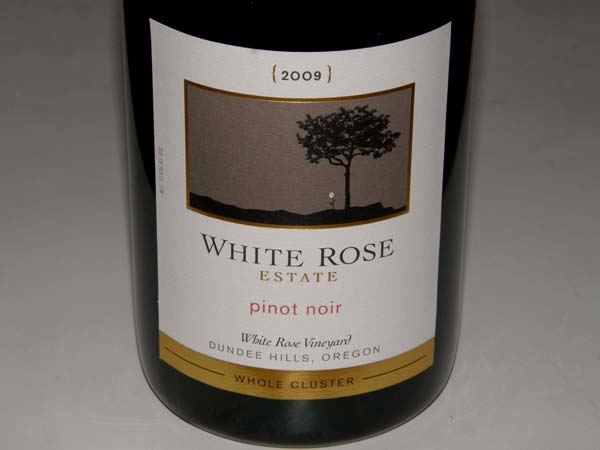
2011 Oregon Pinot Noir All-Americans Honorable Mention
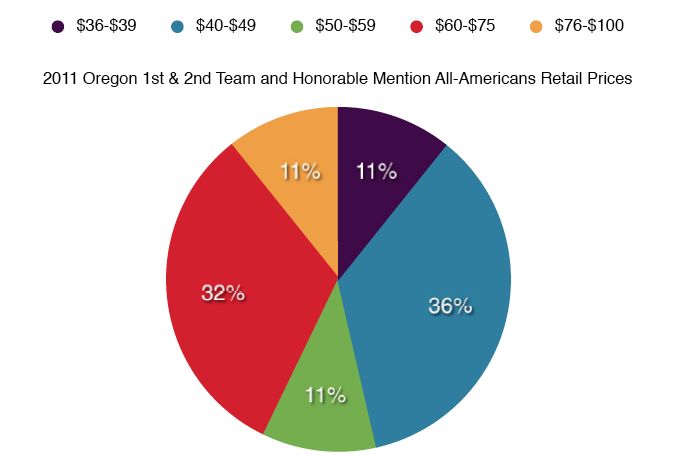 The chart above indicates that 47% of the wines were priced between $36 and $49 and 53% of the wines were priced between $50 and $100. Similar trend as for California Pinot Noir with 5% more Oregon wines priced less than $49. The $50-$59 range seems to be a relative dead zone for winery pricing for California and Oregon Pinot Noir, with the majority of wineries either choosing to price their wines less than $50 or above $60. There must be a marketing lesson in there somewhere but I am not sure what it is.
2011 Oregon Value Priced Pinot Noir All-Americans
• 2008 Argyle Reserve Willamette Valley $30 • 2008 Et Fille Nicholas Vineyard $34 • 2009 Luminous Hills Estate Grown Yamhill-Carlton District Astra $35 • 2009 The Eyrie Vineyard Dundee Hills Willamette Valley $35

2011 Chardonnay All-Americans
2008 Bjørnstad Ritchie Vineyard Russian River Valley 2010 Briceland Vineyards Lolonis Vineyard Mendocino County 2009 Chanin Wine Co. Los Alamos Vineyard Santa Barbara County 2009 Freestone Pastorale Vineyard Sonoma Coast 2009 Hirsch Hirsch Vineyard Sonoma Coast 2009 Lucia Santa Lucia Highlands 2005 Littorai Theirot Vineyard Sonoma Coast Pinot Noir 2007 Mount Eden Estate Santa Cruz Mountains 2007 Rhys Vineyards Alpine Vineyard Santa Cruz Mountains 2007 Suacci-Carciere Heintz Vineyard Sonoma Coast
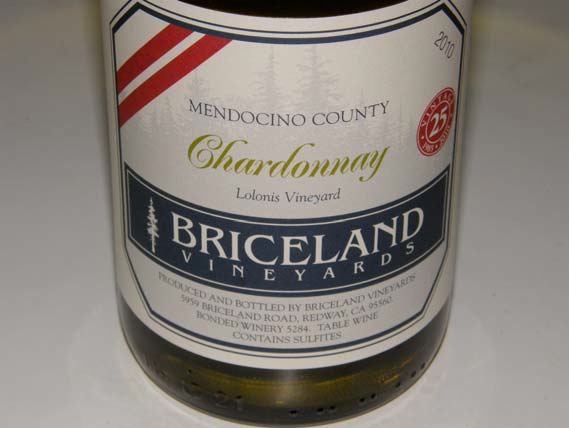
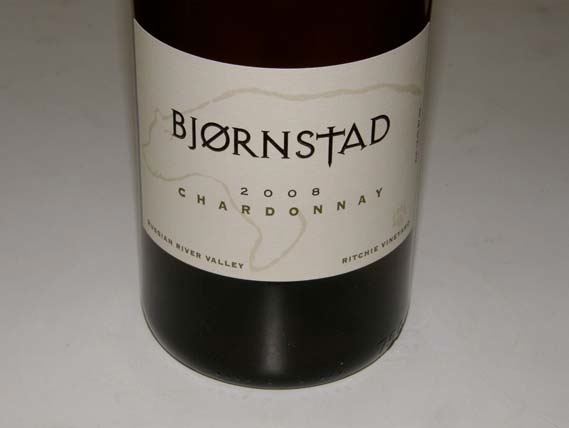
2011 Value Priced Chardonnay All-Americans• 2010 Briceland Vineyards Lolonis Vineyard Mendocino County $21 • 2008 Bjørnstad Barbed Oak Vineyard Bennett Valley $30 • 2008 Lucia Santa Lucia Highlands $35
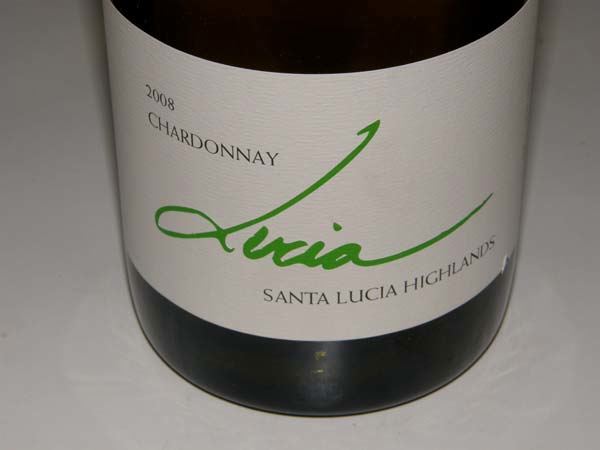
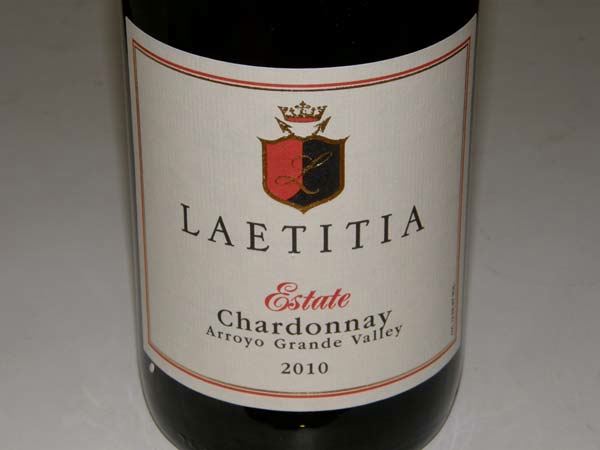
American Pinot Noir Awards for 2011
The following wineries made an impression on me in 2011 as either relative newcomers whose recent vintages were very solid or even outstanding, or as wineries whose wines I sampled for the first time and was suitably impressed. Despite the marked increase in the number of Pinot Noir producers post-Sideways (2004), there are still new hounds eagerly entering the Pinot race. There are some newbies that are producing Pinot Noir that is of borderline acceptability and charging way too much, but all these wineries are worthy of your attention.
Alexana Winery (Willamette Valley)
John Steinbeck Award: Best Winery NewsletterNewsletters in print form are a vanishing breed. I still love to receive them though, and eagerly read every word. The Navarro Vineyards Newsletter can hardly be considered a newsletter as it consists of ten or so pages in a booklet format packed with useful information and color photographs. The Navarro newsletter has been published longer than any of the others listed here and is a masterpiece of marketing know how.
Dutton-Goldfield
A special mention should go to a retailer newsletter: Stock Report from the Wine Exchange (www.winex.com) in Orange, California. This monthly 50 to 60 page newsletter is packed with wine reviews that are carefully written by the owner who has an experienced palate and a way with words. The reviews appear in the writer’s own handwriting which makes them even more appealing. As with all retailers, there is an emphasis on scores, but look beyond this for the true story on the wines. This retailer carries one of the most extensive stocks of California and Oregon Pinot Noir in the country and the prices are competitive with anyone hawking wine in this country.
I visit multiple winery websites daily and honestly, the majority of them suck. It is unfortunate, for the quality of a winery’s website directly reflects the owners, winemakers and the wines themselves. I can’t tell you how many times I have reviewed a wine that impressed me, decided to write about, only to find little useful information communicated on the poorly designed website. Often simple information like owners of the winery, e-mail contacts for the owners or winemaker, useful tech information, and label images is missing. The result is that I spend considerable time searching the internet and making phone calls to try to track down critical facts. The websites below are exemplary. Any wineries needing help? Contact Wendy Coy at wendy@coydesign.com or my son, Dane Gaffney, at danegaffney@gmail.com.
Bailiwick Wines
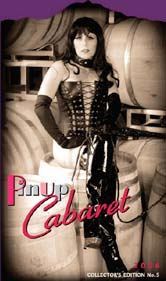 There is no question that wine labels sell wine and are the most important piece of communication between the winery and the consumer. Sexy labels often drive sales. Paula Sugarman wrote (www.winelabelsthatwork.com), “Labels with scantily clad or naked women are popular....to both genders because they both find wine and beauty an appealing combination. Both men and women like the Marilyn Monroe wine labels. Keep it sexy, keep it simple, or dress it up, but stick with the classics.” I haven’t seen many scantily clad women on Pinot Noir labels recently, except for the PinUp Series of wines by De La Montanya Winery in Healdsburg (right) and the three labels pictured below (one of which is Sauvignon Blanc), but the Pinot Noir labels for the Van Gogh Award are my favorites.
Undone
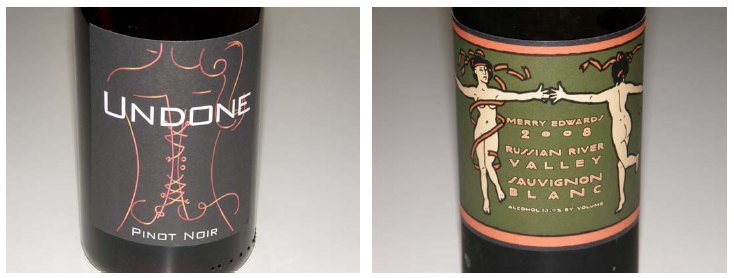
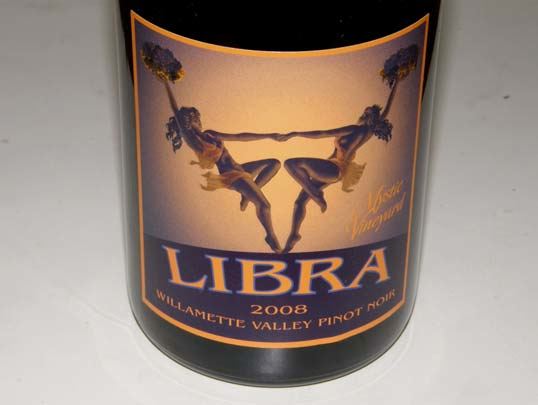
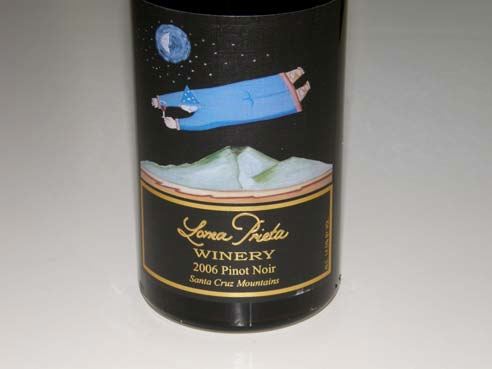
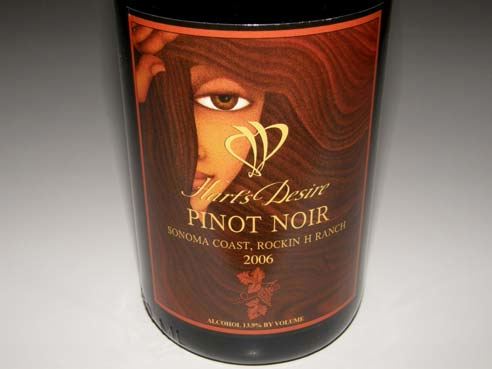
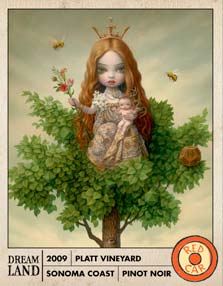
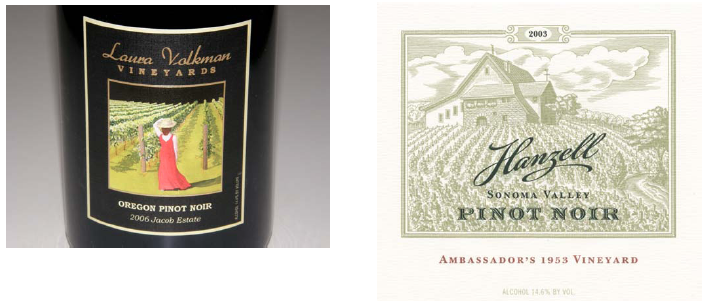
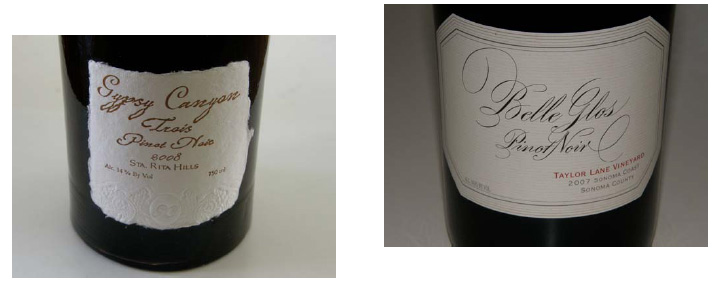
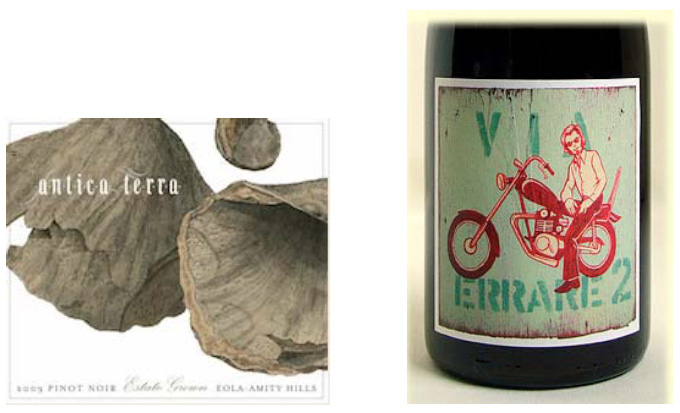
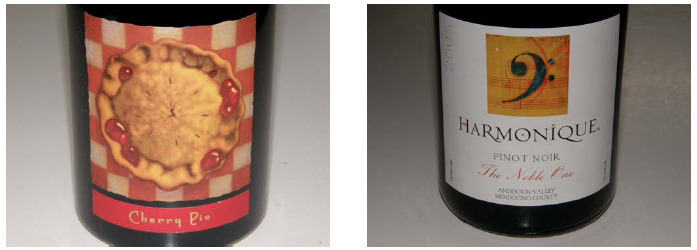
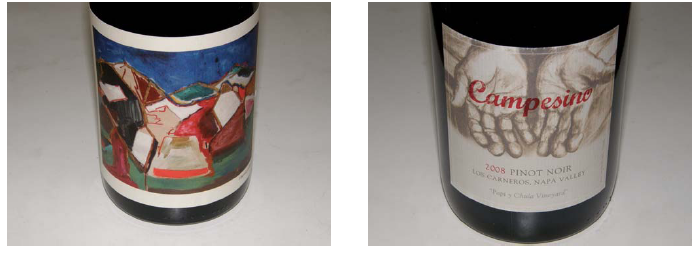
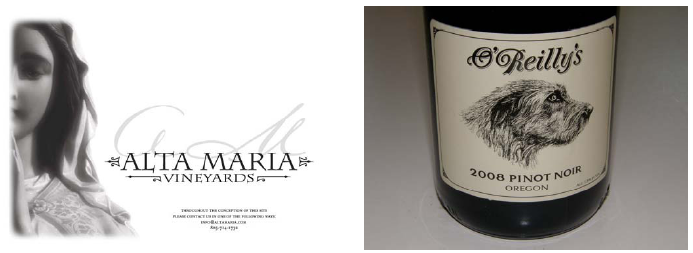
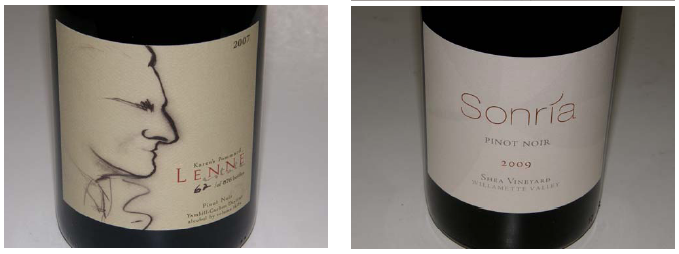
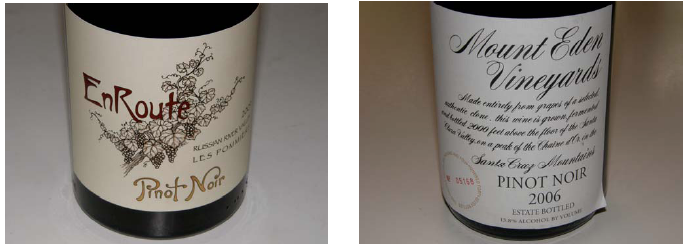
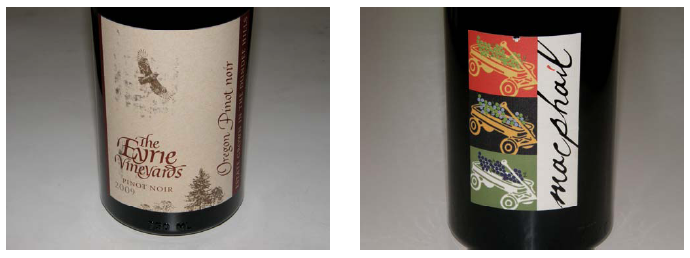
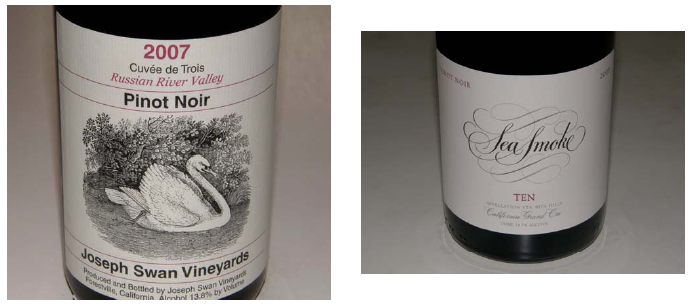
Books That Go Well With Pinot Noir
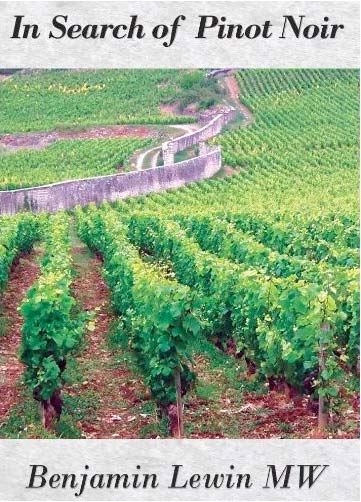 The title is misleading as this book is a homage to Burgundy. Lewin notes, “Burgundy makes Burgundy. All the rest make (merely) Pinot Noir.” Further, he states, “Burgundy has the pinnacle all to itself for Pinot Noir.” He establishes this premise early on in the book and then begins to prove his case with extensive historical material on the origins of Pinot Noir and the history of Burgundy, a very enlightening discussion of the significance of the region’s terroir, and lengthy tasting notes of exemplary Burgundian Pinot Noirs including recommended drinking windows. He then takes the reader on a trip to other French Pinot Noir producing areas including Sancerre, Champagne and the Languedoc, European Pinot Noir regions such as Germany, Italy, and Switzerland, California and Oregon, and New Zealand and Australia in the southern hemisphere. The New World versus Burgundy is a tired argument and the argument as presented in the book is agonizing long. Lewin states his case at several points in the book. He notes at one juncture, “The transparency of Pinot Noir can show subtleties of terroir as effectively in the New World as in the Old. Two factors stand in the way of a full appreciation of terroir in the New World....the vines are young....and the style of full frontal fruits isn’t best suited to reveal subtlety of terroir.” I believe he is remiss in acknowledging the Pinot Noirs from Pisoni Vineyard or Rochioli Vineyard where the exuberance of the fruit IS a reflection of the terroir. The coverage of North American Pinot Noir is woefully lacking with an emphasis only on Santa Barbara County and the Russian River Valley. Santa Cruz Mountains receives but two paragraphs, and the much heralded Pinot Noirs from the extreme Sonoma Coast (except for a cursory mention of Hirsch Vineyard), Anderson Valley, and Sta. Rita Hills are largely ignored. There are a few inaccuracies along the way. Although David Lett is correctly given credit for launching the modern Oregon wine industry, his first plantings in the Willamette Valley were in 1965 and not 1967 as is stated in the book. Charles Coury is given credit for writing a thesis that suggested that Oregon should plant Pinot Noir, but no such information is contained in Coury’s graduate thesis which was titled, “Wine Grape Adaptation in the Napa Valley.” Lewin attributes the University of California at Davis for advising Joe Rochioli, Jr., to plant grapevines in the Russian River Valley in the 1960s, when grapevines had been growing on the property Joe Rochioli, Jr., acquired for many years prior, and it was Joe’s idea to plant Pinot Noir. I found it humorous that Lewin frowns on the limited availability of top single-vineyard Pinot Noirs from Oregon and California, saying, “The near universality of the model (allocation) means that unless you are in the magic circle of aficionados, you may never experience the range of single vineyard wines.” Later in the book he touts the wines of DRC and Leroy, yet they are far more expensive and allocated, and even less rarely experienced by the American wine enthusiast. The book concludes with a description of a tasting to compare aging of top wines from different regions by identifying wines with the same apparent maturity as Burgundy 1995. The author concluded from the tasting that Pinot Noir from a variety of climates and terroirs can produce interesting results with age, but considered many wines in the tasting to be only at the village wine level of Burgundy. I plan to read this book many times for there is plenty to learn here. Pinot Noir lovers at all levels will be captivated by the detail contained within, and thoroughly enlightened by the extensive charts, maps and photos included, whether are not they are devotees of New World Pinot Noir, Old World Pinot Noir, or hopefully, both.
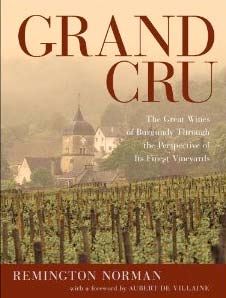 When I first traveled to Burgundy, I bought Remington Norman’s book that explores the greatest producers of Burgundy, The Great Domaines of Burgundy, in Beaune, and carried it with me everywhere I went. The last edition of that book was published in 1996, but it remains a valuable reference. It was therefore not surprising that I looked eagerly to reading Norman’s latest book and I was not disappointed. Grand Cru assumes a different tact, concentrating on vineyards rather than producers with extensive profiles of all the Grand Cru Vineyards in Burgundy and the Premier Cru Vineyards that come closest to and are possibly deserving of Grand Cru status. Although, as Norman points out, Burgundy’s Grand Cru vineyards (white and red) amount to just over 1% of the total vineyard area and less than 1% of the wine production of Burgundy, they remain a source of unparalleled interest to Burgundy lovers. Although Grand Cru Vineyards are the meat of the book, there is much more, including extensive coverage of the Côte d’Or in the context of history, the importance of terroir, the significance of vintages in Burgundy, how to taste and buy Burgundy (or any great wine), pairing Burgundy with food, and the current state of Burgundian grapes in the New World. What you won’t find in this book are extensive tasting notes and specific wine recommendations. You will find many valuable bits of information and quotes to hang your Pinot cap on. For example, Norman waxes about La Tâche, saying, “The real impact of a great Côte d’Or Grand Cru is as emotional as it is sensorial so one can only hint at the magic and encourage people to pool resources and share a bottle.” In discussing wine tasting, he says, “A useful tip with tasting young wine is to smell the glass that has been empty for a minute or so; this offers an artificial glimpse of how it might develop in the bottle.” When discussing wine quality, he muses, “The greater the wine, in general the more difficult it is to taste young and the slower its progress toward maturity. The book is replete with glorious photographs of Burgundy as well as color aerial photographs of the vineyards described. A helpful appendix clarifies the various measures of wine-related capacity, yield, and area in several countries. This is an incredible work that took considerable dedication over many years to bring to print. I would consider it required reading for even the most mildly afflicted pinotphile. My only nit is a little repetitiveness in parts, but this can easily be forgiven by the author’s profuse love for Burgundy expressed so eloquently in this magnificent book.
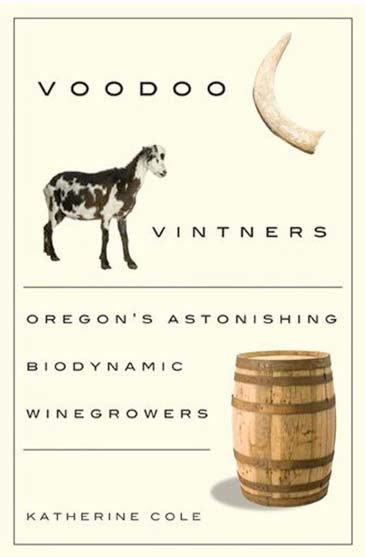 There are few subjects in viticulture more controversial than biodynamic (BD) farming. The word “voodoo” crops up at various junctures in this book, a term implying a mystical or spiritual basis for this practice. When this book was first released, I mentioned the title to Ted Lemon (California’s Littorai winery), a staunch believer in BD, and he cringed. To emphasize the conflicting opinions about BD, a number of viticulturists would not go on record with statements about BD in this book. There hasn’t been much scientific research on BD, and the author points out that a few studies have even found BD agriculture to have no measurable effect on soil health and little evidence that the preps contribute to grape quality. Practitioners of this ultimate form of sustainable farming must take a leap of faith. The author presents a generally supportive view of this practice as told through vignettes of prominent Oregon winegrowers including Moe Momtazi (Maysara), Robert Gross (Cooper Mountain Vineyards), Laurent Montalieu (Soléna and Grand Cru Estates), Don Huggett (Montinore Estate, Brian O’Donnell (Belle Pente), and Mike Etzel (Beaux Frères) among others. At the time the book was written there were 909 vineyard acres in Oregon, or 5% of the total vineyard land, certified Biodynamic® (the word is trademarked and to be used only by Demeter-Certified wineries to market or label wines, but can be used in a broader sense without the trademark to describe BD farming techniques). 365 acres are non-certified Biodynamic® bringing the total in Oregon to 6.5% of the total vineyard land. A master list of natural and biodynamic wine producers in the world (currently 529) is available at www.forkandbottle.com/wine/biodynamic_producers.htm. At the recent organic and biodynamic debate held in the UK, Monty Waldin noted that over 5% of the world’s vineyards are now organic and biodynamic. There are few sources of information about BD (“There are no Cliffs Notes,” the author points out), so Cole has done an admirable job filling this void by collecting all the important current knowledge about BDs origins (from the agricultural lectures of Rudolph Steiner dating to 1924), its practice (compost piles, cover crops, irrigation limitations, buffer zones, integration of livestock, minimal sulfur and copper usage), important BD organizations (the headquarters for Demeter USA and the Biodynamic Farming and Gardening Association is based in Oregon), and certification requirements. Viewpoints from both BD’s practitioners and naysayers are offered, with limited discussion given to the latter group because, other than Richard Smart, there are few outspoken prominent opponents to BD. The author is not a scientist or even a viticulturist, but a wine columnist for The Oregonian and Portland’s magazine about food and drink called MIX. This is a good thing, for she does not attempt to present a treatise on BD, but chooses to offer a highly readable story centered on Oregon winegrowers sprinkled intermittently with useful and accurate information on BD. I am not sure the BD winegrowers are “astonishing” as the title would suggest, but they are certainly fascinating.
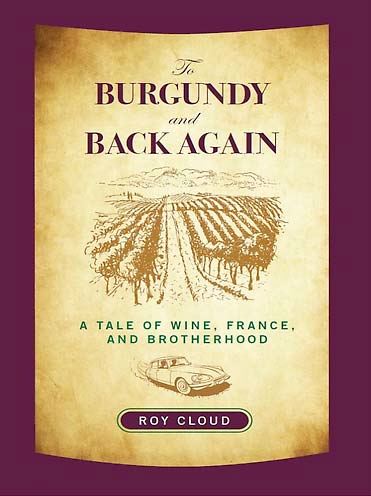 Roy Cloud had worked in the wine business in the United States for years, but in 1997 he was confronted with an unusual assignment. The United States import market was heating up and he was asked to quickly acquire a portfolio of vignerons for a new wine importing company. Nothing unusual about that except that Cloud spoke no French, had never been to Burgundy and had no contacts there, and possessed little experience in importing and distributing fine wine. He did have an older brother, Joe, who spoke French and was available to join him, and the two of them embarked on a twelve day whirlwind life-changing tour of Burgundy. As wine novices, the pair’s escapades in the cellars of Burgundy are humorous. Not all the domaines that are visited are named, but those familiar with Burgundy can surmise which ones were visited. The tour also includes brief stops outside Burgundy including Sancerre, Alsace, and the Rhone, where at Château de St. Cosme, Joe is trying to be diplomatic to the proprietor and winemaker, Louis Barruol, after being taken aback by a big wine that was offered for tasting. Challenged by the winemaker to describe the wine, Joe uses the term “expressive” to downplay the richness of the wine. The winemaker responds, “Anyone can make a fat wine. That’s easy! But what is fat wine without freshness, without definition? He stuck his butt out and went ttthhhiiiiiiiiddd with his tongue. Just a fart in the wind. And there is a lot of farting out there. Too much farting. Don’t you agree?” As you can imagine, the tour turned out to be quite an adventure and a bonding experience for the brothers. Cloud writes, “We raced all over the Cote d’Or in a hallucinogenic haze induced by lack of sleep, alcohol, and anxiety at having to perform in front of strangers.” He recants, “We were starting from scratch. We had no reference, no track record, nothing. What I was doing was ridiculous, a fool’s errand.” Roy Cloud is an engaging writer who holds an MA in writing from New York University. He eventually bought the importing company that first sent him to France and renamed it Vintage ’59 Imports, reflecting a famous vintage in France as well as Cloud’s birth year. The company is based in Washington, D.C. and specializes in artisanal French wines.
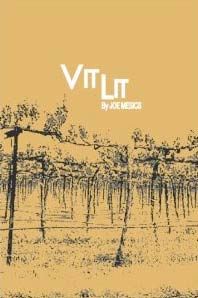 I devoured this book over a few hours as it contains a series of short essays in a column titled “Vit Lit” that the author wrote for The Healdsburg Tribune under the pseudonym F.l Gangbardt between 2008 and 2009. Mesics was a devoted winegrower who started a vineyard in Rickerall, Oregon in the 1960s after a career in the magazine publishing industry. He later moved to the Russian River Valley, and at age 55 planted Timbervine Ranch Vineyard on the flanks of Black Mountain. The vineyard consisted of several acres of Zinfandel. He lived nearby on a ranch on Westside Road called Por Que Ranch where he produced wine from a tiny winery known as Itty Bitty Cellar at Por Que Ranch. The essays cover subjects ranging from field laborers to hardware stores to terroir, and contain plenty of insider jokes that only those who have lived or spent considerable time in the Russian River Valley will understand since the people that are described are not named. In spite of that, all winos will enjoy the read since he writes from the heart about what farming grapes is really like and how winegrowing has changed since he began in the 1960s. Mesics has a special hatred for weekend farmers, rich retirees who “bought into the romance of viticulture,” as he puts it. He wrote, “Some days bad things happen at the mountaintop. Pumps clog, motors overheat, batteries fail....hornets attack workers, and winemakers demand more attention be paid to leaf pulling or dropping a crop. Unless you experience such surprises, you’re not really experiencing the Romance of Viticulture.” I found myself laughing out loud at several junctures of the book. Tragically, Mesics passed away before his book was published. This is not a book that will receive wide recognition or press, but it is honest writing that truly conveys one man’s love for viticulture. As Mesics put it, “I’ve never met a grapevine I haven’t liked.” I can just imagine his weathered skin and gnarled hands, and regret that I never met the man.
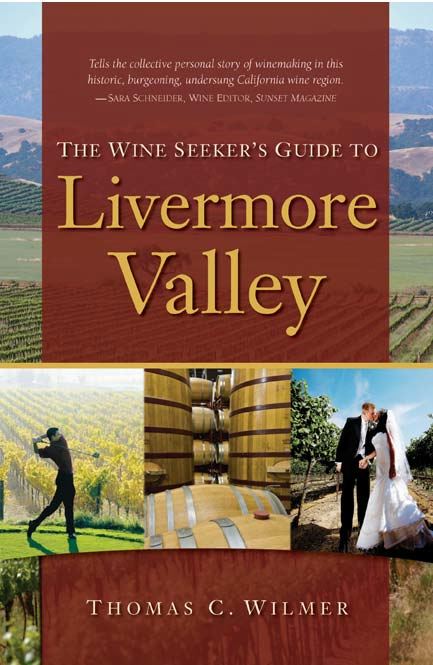 This is the first published comprehensive guide to this under-appreciated California wine region which has been quietly been producing wine for more than 125 years. 15 miles long and 10 miles wide, the Livermore AVA was approved in 1982. Because of east-west oriented mountains that flank the valley, the climate is coastal, with marine air and fog intruding from San Francisco Bay. The history of the region is documented in this handy guide and includes a forward by Phil Wente and James Concannon. The Wente family brought Chardonnay clones to the region from France in 1912 and today more than 80% of Chardonnay plantings in California are some variation of the Wente clone. The first varietally-labeled Sauvignon Blanc and Petite Sirah came from Livermore Valley. Pinot Noir plantings are sparse and Pinot Noir has been a minor variety for nearly all producers in the region except La Rochelle Winery which sources Pinot Noir from several AVAs in California and Oregon. The signature varietals of Livermore Valley are Petite Sirah, Syrah, Zinfandel, Sangiovese, Cabernet Sauvignon, Merlot, Sauvignon Blanc, Pinot Gris, and Chardonnay. This tour guide is not a serious wine reference and does not include wine reviews or judgments about the quality of the wines from the wineries, but insightful vignettes of each winery are presented. I discovered that a number of wineries beside La Rochelle do produce Pinot Noir from sourced grapes including Charles R Vineyards, Crooked Vine & Stony Ridge Wineries, Darcie Kent Vineyards, Elliston Vineyards, Fenestra, Page Mill Winery, Rodrique Molyneaux, Wente Vineyards, Westover Vineyards, and White Crane. This is a useful book to throw in the glove compartment of your car as you tour the region. Maps, lodging, restaurants and things to do and see in the Livermore Valley are presented in detail. A mobile version of the guide would be even more helpful.
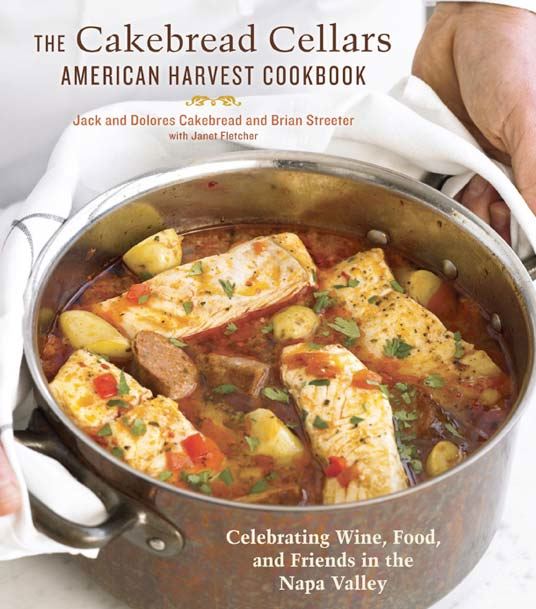 This book features recipes from the American Harvest Workshop hosted by the Cakebreads each September during harvest season. The release of this cookbook in 2011 coincides with the 25th anniversary of this event which is held over four days at River Ranch Vineyard in the Napa Valley. Five chefs from the United States are invited each year and attendees include a mix of trade people, journalists, and the public. 100 seasonal recipes are included by such famous chefs as Gary Danko, Herbert Keller and Charlie Trotter. The recipes focus on local (“locavore”) sources of food and therefore California cuisine, and a number of them have been streamlined for home cooks. Scattered throughout the book are informative profiles of the winery’s purveyors such as Devil’s Gulch Ranch rabbit and Liberty duck, and the book’s appendix includes sources for difficult to find ingredients. The book is intended to be a working cookbook rather than a glamorous picture book, with color photographs included primarily for guidance. I tried a few of the recipes successfully, including Fennel-Brined Pork Chops with Quince Chutney and Slow-Roasted King Salmon with Garden Herbs, both of which clicked beautifully with Pinot Noir from my cellar. This is a user-friendly and wine-friendly cookbook that includes a number of recipes using wine in the preparation. In addition to the newer books reviewed above on Pinot Noir, I have compiled a list of previously published books to stock your library below. A few of these, such as North American Pinot Noir, are available in e-book format.
North American Pinot Noir, John Winthrop Haeger Pacific Pinot Noir A Comprehensive Winery Guide for Consumer and Connoisseur, John Winthrop Haeger Passion for Pinot, photography by Andrea Johnson & Robert Holmes, text by Gordon MacKay Essential Wines and Wineries of the Pacific Northwest, Cole Danehower, photography by Andrea Johnson A Wine Journey Along the Russian River, Steve Heimoff Santa Barbara County Wineries, Janet Penn Franks The Heartbreak Grape, Marq De Villiers The Grail A year ambling & shambling through an Oregon vineyard in pursuit of the best pinot noir wine in the whole wide world, Brian Doyle The Boys Up NorthDick Erath and the early Oregon winemakers, Paul Pintarich Vineyard Memoirs or “So this is what it’s like to plant a vineyard?”, Oregon Wine Pioneer Recollections of Living, Grape-Growing and Winemaking in the 1970s, Kerry McDaniel Boenisch Sideways and Vertical, Rex Pickett The Great Domaines of Burgundy, Remington Norman The Wines of Burgundy, Clive Coats, MW Inside Burgundy, Jasper Morris Adventures in Burgundy, photography by Lincoln Russell The Pearl of the Cote: The Great Wines of Vosne-Romanée, Allen Meadows Romanée-Conti, Richard Olney The Science of Wine, Jamie Goode The Taste of Wine, Emile Peynaud
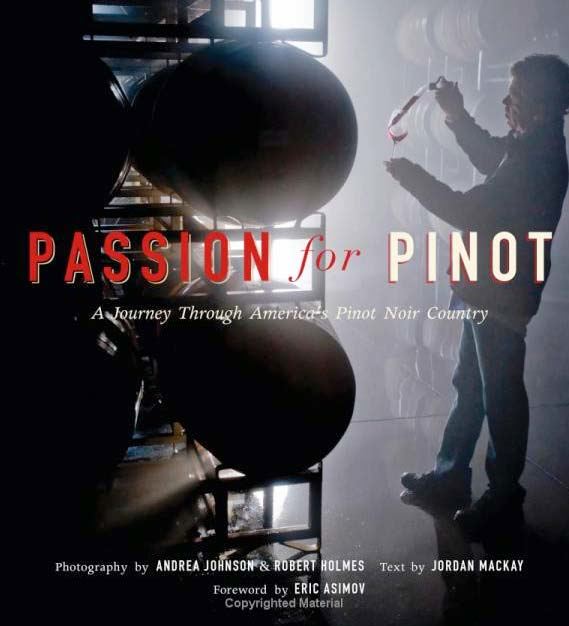
The Prince, A Scrooge?
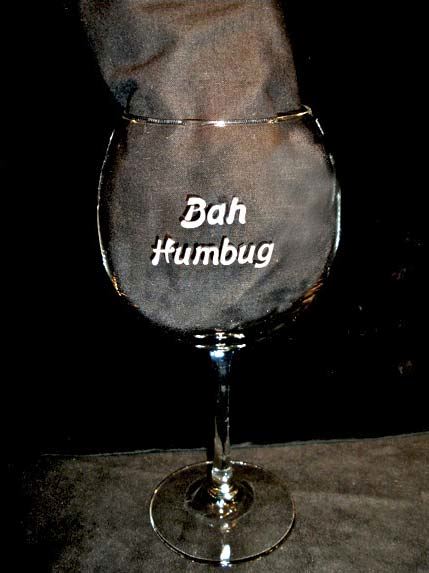 Bah,Humbug! to sweeping pronouncements about vintages, regions, etc. At this year’s Wine Spectator New York Wine Experience, contributing editor Matt Kramer hosted a session on Sonoma Coast Pinot Noir. He called the extreme Sonoma Coast the source of “the most profound Pinot Noirs grown in America today.” I do love many of the Pinot Noirs originating in the true or extreme Sonoma Coast, but to make such a statement belittles the incredible Pinot Noirs produced by Calera Wine Company at Mt. Harlan, by Hanzell Vineyards on Sonoma Mountain, and by Mount Eden and Rhys Vineyards in the Santa Cruz Mountains, to name a few. Bah, Humbug! to heavy glass bottles. Wine writers hate them (ie Dan Berger, Paul Gregutt), sommeliers despise them, and I dislike them. They don’t fit into my home Vinoteque wine cabinet and they are unwieldy to pour from. Lifting cases of heavy bottles can lead to serious back problems (a case of heavy bottles weights about 43 pounds) and cases of heavy bottles are more expensive to ship. Glass represents anywhere from 50 to 73 percent of a winery’s carbon footprint and switching to lighter weight bottles can greatly reduce the carbon footprint and save wineries money. I assume their popularity among wineries is loosely based on the perception that consumers will consider the wine contained therein of higher quality and worth the often higher prices. I don’t think wine reviewers are impressed or influenced by the massive bottles and huge punts. Bah, Humbug! to wax closures. I would be the first to acknowledge that wax closures are pleasing to the eye and give the wine packaging a desirable flare and sophistication, if not expensive aesthetic. That said, they are a pain in the touche to deal with. After driving a worm through the wax to open the bottle, the wax invariably fragments, sending pieces everywhere including into the wine when the cork is finally liberated. Bah, Humbug! to alcohol percentages on labels so tiny that they defy readability except for those young people gifted with 20/15 vision. The TTB requires that alcohol content appear on the label no smaller than 1 millimeter and no larger than 3 millimeters. Many vintners choose to put the alcohol content in 1mm black print on a very darkly color label, essentially hiding it, and making deciphering a challenge. I urge wineriers to put the alcohol percentage somewhere on the front or back label in a size and with enough contrast to be easily read. While your at it, can you please put the “honest” alcohol level on the bottle? Bah, Humbug! to over-oaked Pinot Noir. It is true that no one is certain what Pinot Noir is supposed to taste like, but I seriously doubt that oak is high on the list. Kudos to the many vintners who are favoring less new oak or eliminating new oak completely. Bah, Humbug! to wine collectors attempting to sell wines from their overstocked cellars at exorbitant prices. Don’t pay absurd prices on the secondary market for so-called cult Pinot Noirs! They just aren’t worth it. I recently bought some Pinot Noirs from a serious wine collector in Southern California who needs to thin his cellar. Admirably, he is selling the wines at his cost. Some of the producers available reads like a who’s who in the PinotFile: A.P. Vin, Arcadian, Arista, Benovia, Clos Pepe, Domaine Drouhin Oregon, DuMOL, Kanzler, Kosta Browne, Kutch, Littorai, Loring, MacPhail, Native 9, Peay, Penner-Ash, Privé, Radio-Coteau, Rhys Vineyards, Rivers-Marie, ROCO, Sea Smoke, Skewis, Stoller, WesMar and Williams Selyem. The wines have been properly cellared after their acquisition directly from the wineries. To obtain the list of wines for sale contact dave@loverofwine.com. Bah, Humbug! to the explosion of scores of American Pinot Noir at or above 90 out of 100 points, the result of so-called “creeping grade inflation.” The blog, Fermentation, written by Tom Wark, recently noted that 78% of the 2009 California Pinot Noirs rated by Robert Parker, Jr., were given a score of 90 points or better. Certainly 2009 was a great vintage for Pinot in California, but it isn’t realistic to think that so many wines deserved such exalted scores. It seems to me that every winery I know has a Pinot Noir that has scored 90 or above by some publication or competition. The recent tasting report by James Laube in the Wine Spectator was more realistic. Even though Laube raved about the 2009 California Pinot Noirs (“09 is head and shoulders above any other vintage in California Pinot Noir history”), 55% of the 350 wines tasted achieved a score of 90 or above which was the best performance for this category ever. Writers have pointed out that this grade inflation decries the 100 point scoring system because so many wines are considered superior. All the more reason not to chase high scoring wines but rather pursue a producer with a broad work of excellence. Bah, Humbug! to those who are afraid to trust their own palate. If you like it, then it is a good wine. There is no accounting for taste. As wine importer Neal Rosenthal has proclaimed, “Your taste is your own. Your patrimony. You play with it as you play with your hands.” Wine critics can enhance and direct your wine experience, but they cannot be your wine experience. There are very few really bad Pinot Noirs from reputable sources on the market today. Be more concerned with differences than what is good or bad. Bah, Humbug! to consumers who equate price with quality or quality with price. You know who you are. You believe the best Pinot Noir costs the most and vice versa. It is true that you get what you pay for and many of the best Pinot Noirs are expensive, but you may find you get equal enjoyment from any number of modestly priced Pinot Noirs. As Alex Hunt has pointed out, we should seek the opposite tendency and equate desirability with quality. My suggestion is to gather several wine drinking buddies, bag a dozen Pinot Noirs priced from $18 to $100, and then taste and rate individual preferences blind. If you can’t bear to do it with friends, do it by yourself with your dog by your side, because he will be oblivious to your embarrassment. A study by Johan Almenberg and Anna Dreber in the Journal of Wine Economics (Vol. 6, No.1, pp 110-121, 2011) designed an experiment to examine how knowledge about price of a wine affects how the wine is experienced. They found that disclosing a high price before tasting the wine produced considerably higher ratings, but only from women. Disclosing a low price did not result in lower ratings. I think the results would be different if the people tested were experienced wine drinkers. Bah, Humbug! to the excess of single-vineyard Pinot Noir bottlings. The truth is that blended wines can offer more nuances and complexity, more consistency, and are often priced less than single vineyard Pinot Noirs. This year’s number one wine among the Top 100 in the Wine Spectator is the 2009 Kosta Browne Sonoma Coast Pinot Noir which is a blend of three vineyards. The fact is, many vineyards are not worthy of single-vineyard designation. That said, single-vineyard Pinot Noirs can be the most stunning of all Pinot Noir wines and all but three of my 2011 California and Oregon Pinot Noir All-Americans are single-vineyard designates. Bah, Humbug! to label kissers. Don’t drink labels. As University of California at Davis Professor Dr. Maynard Amerine has said, “It is not the year, the producer, or even the label that determines the quality of the wine; it is the wine in the glass, whatever the label or producer or year.” Bah, Humbug! to uninformative, lackluster winery websites. Wineries should disclose as much information about themselves and their wines as possible on their website. Pinot geeks clamor for it and wine writers need it. Provide copies of all wine labels; these visual images help the consumer to connect and assist the wine press in spreading the winery’s image. Include an e-mail address for contacting the winemaker for questions. Keep the information current.
*”Bah Humbug” wine glasses available from www.hourglassstudio.com.
Pinot BriefsNo Sulfites in “Organic Wine” The United States National Organic Standards Board recently passed a ruling that prohibits sulfites from being added to “organic wine.” A subcommittee had previously advised to allow inclusion of sulfites in “organic wine.” “Biodynamic wines” are unaffected by the ruling and can contain sulfites. The decision on “organic wines” falls in line with other foods that display the preservative-free USDA organic seal. Czar Foods Pinot Noir Sauces Jack and Stefan Czarnecki, chefs at the Joel Palmer House Restaurant in the Willamette Valley, have released four new Pinot Noir sauces made from fruit from Resonance Vineyard. The sauces include The Czar’s Pinot-Pepper Sauce, The Czar’s Pinot-Chipotle Sauce, The Czar’s Pinot-Habanero Sauce, and The Czar’s Pinot Szechuan Sauce. Contact Michael Alberty at www.StoretellerWine.com located in Portland, Oregon for more information and to buy ($7.95 a bottle). Winemaking and Surgery I am a retired eye surgeon and the comparison of winemaking to surgery in Dutton-Goldfield Winery’s latest newsletter caught my interest. Winemaker Dan Goldfield’s spouse is a surgeon and Dan himself originally started out to be a doctor. He points out a few similarities and differences between the two crafts. Why being a winemaker is like a surgeon: (1) The best craftspeople know when to wait, or do nothing, (2) A clean and organized workplace gives a superior outcome, (3) Sometimes our mistakes smell bad, (4) People who love to talk about their last 100 experiences with our professions bore us, (5) One long night at a crucial time can avoid endless unsuccessful efforts later, (6) It’s about the customer, not the provider, and (7) One person gets all the credit, though it takes many who care to do the work. Ways in which winemaking is different: (1) Nobody dies when a winemaker screws up, (2) Winemakers don’t get paid if they screw up, (3) Wine is a great barter product but few want to trade for surgery, (4) There are far more home winemakers than home surgeons, and (5) Harvest only lasts a month or two. Dutton-Goldfield Winery is located in Sebastopol and produces an outstanding range of wines including Pinot Noir, Syrah, Zinfandel, Chardonnay and Pinot Blanc. Visit the website at www.duttongoldfield.com.
 Mobile App to Assist Wine Shoppers The Northern California retail chain of 124 supermarkets known as Raley’s Family of Fine Stores is offering shoppers a free mobile app for iPhone and Android devices that assists shoppers in choosing wine from the bewildering number of offerings in a market’s wine aisles. Created by Hello Vino, Inc., the mobile app will direct shoppers to the proper wine from the supermarket’s inventory that matches personal taste preferences, price point, and suitability for certain foods. For more information, visit www.HelloVino.com. Vancouver Microbiologist Aims at Making Wine Healthier The story of Hennie van Vuuren’s research is profiled in Macleans.ca by Ken MacQueen (November 17, 2011). At the Wine Research Center at the University of British Columbia, Vuuren has invested seven years of research to create a GMO malolactic yeast (ML01) that eliminates the biomine allergens in finished wines that cause headaches. Vuuren himself is a wine lover and suffers from wine-induced headaches. The commercially available yeast is approved for use by Canadian and American authorities. Vuuren and his fellow researchers have also developed a group of yeasts that almost eliminate ethyl carbamate, a suspected carcinogen found in trace levels in wine, distilled alcoholic beverages, and bread. 80 wineries in the United States tried the yeast last year and found no differences in quality between wines made with and without the new yeast. Vuuren is also researching a yeast to reduce high levels of alcohol. Stay tuned. Visit www.macleans.ca/. Study Suggests Beer as Good as Wine for Health Italian researchers reported in the European Journal of Epidemiology that a moderate daily intake of beer (about a pint a day) cuts the risk of heart disease by 31 percent. The researchers also found that beer was as good as wine for heart health. The results are not surprising since a pint of beer and a glass of red wine contain about the same percentage of alcohol, and most studies in this field have found alcohol to be the ingredient in both beverages most responsible for reduction in heart disease. The authors caution that excessive beer or wine intake leads to a loss of the advantage that moderate alcohol consumption confers, greatly increasing the risk of heart disease. 107-year-old Australian Woman Believes in Red Wine and Chocolate The Herald Sun reported that a 107-year-old woman recently celebrated another birthday and attributes her longevity to red wine, chocolate, fresh air, sunlight and a good cup of tea. No word about how much red wine she drinks, but it is well known that moderate amounts of wine in the elderly can have multiple health benefits including the preservation of cognitive function as well as promoting longevity. Electronic Nose The Swiss government’s federal research station at Wädenswil has announced that their electronic nose, termed SMart Nose, is, well, smart, and threatens to replace human noses that currently do much of the work in the food industry. As reported at www.genevalunch.com (November 15, 2011), “In theory, verifying the technical aspects of a fine bottle of Pinot Noir and quantifying these, as well as being able to describe the nose, could be done by a machine.” At first glance this may threaten the livelihood of wine writers, but the machine cannot give a subjective impression or a score, at least not yet. More Clarification on Chalone Vineyard Clones In the last issue of the PinotFile, I wrote about the presumed source of some clones planted at Calera, quoting John Haeger who said in North American Pinot Noir, “There are persistent rumors that budwood brought at various times from France found a home at Chalone. In some versions, the home was permanent and MacWood Vineyard is said to be planted to a suitcase clone. In other versions, Chalone was only a way station for the imported budwood, which was subsequently transported to other California vineyards. At this point, none of these stories can be confirmed with certainty.” In the book, “Heartbreak Grape,” Marq De Villiers, who knew Josh Jensen intimately, states, “Everyone cheerfully believes the rumors that Jensen’s Pinot Noir stock came directly from DRC itself, bypassing Customs...Or, if not directly, via Chalone. Or possibly Chalone got its cuttings from Jensen, who got them, somehow, from DRC....which he propagated on a patch of Chalone vineyard when he got to California. Jensen’s “suitcase” clones have become legend in California and have subsequently mutated into the ‘Calera clone’ in the minds of the state’s high-end pinot growers.” Dan Karlsen, the General Manager and Winemaker at Talbott Vineyards, held the same position at Chalone from 1997 to 2006 contacted me recently to clarify. He said Dick Graff’s brother told him that the Pinot Noir clone from Chalone was Martini, probably obtained from Wente in the late 1940s. He believes there were no suitcase clones at Chalone. Karlsen was at Chalone when the original 1946 plantings were pulled out and he supervised all the Pinot Noir replanting at Chalone which is 100% Dijon clones. Karlsen points out that it is true that Chalone “harbored” some plant material for various wineries through the years, but it was all in very small patches which were never sold, never expanded into production blocks at Chalone, and now are long gone. His observation is that the Martini/Beaulieu/ Chalone clones are very similar plant material to that he has seen in Carneros, the Russian River Valley, Chalone and the Santa Lucia Highlands. Where did this original material come from? Probably Burgundy and was selected for higher vigor and crop production and its ability to make great wine in great sites.
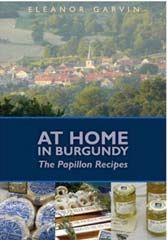 At Home in Burgundy: The Papillon Recipes Eleanor Garvin is a professional chef who has published a selection of over 100 of her most popular recipes she collected while living in France for 25 years. She has worked with Papillon cruises (along with her husband, Denis Sherman, they bought an antique barge “Le Papillon” in 1988 and began offering catered cruises of Burgundy’s canals) and other tours and collaborated with Elden Wine. Her home is in Burgundy and the inventive recipes reflect the abundance of indigenous ingredients available there and the author’s extensive background in Burgundy’s culinary world. Early reviews on Amazon are 5-star. $19.95 (paperback). For additional information on estate bottled Burgundy wine visit www.eldenwine.com, and news about upcoming cruises visit www.papillionselect.com. Lompoc Wine Ghetto Website I recently discovered this website (www.lompocghetto.com) and can recommend it to you for guidance in your tasting trips to the Sta. Rita Hills region. With the recent addition of Arcadian, Joseph Blair Wines and Stolpman, there are now 16 tasting rooms in the Lompoc Wine Ghetto. Evening Land Vineyards is moving its tasting room to a new, larger location. Notable Pinot Noir winery tasting rooms besides Arcadian in the Ghetto include Ampelos Cellars, Fiddlehead Cellars, Flying Goat Cellars, La Vie Vineyards, Longoria Wines, Loring Wine Company, Samsara and Zotovich Cellars. A number of articles in the news about the Lompoc Wine Ghetto are posted on the website. One of the tasting room, Taste of Sta. Rita Hills, which was created and is owned by Antonio Moretti of Moretti Wines, includes 11 wineries with prominent Pinot Noir producers such as Brewer-Clifton, Clos Pepe, Gypsy Canyon, Huber, Ken Brown, Sea Smoke, Seagrape and Thorne. This tasting room is open Thursday through Sunday 11:00-5:00 or by appointment.

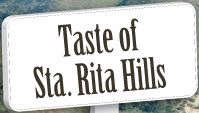 Historic Vineyard Society (HVS) A group of winemakers and winegrowers have banded together to start the Historic Vineyard Society to establish a registry and promote the historic vineyards of California. For inclusion in the registry, the vineyard must be currently producing, date to 1960 or before, and have at least one-third of existing producing vines traceable to the original planting date. The Society has cataloged 202 historic vineyards in California with most in Sonoma County (100 vineyards), but the registry is a work in progress. Most of the existing historic vineyards, some of which are over 100 years old, are planted to Zinfandel, but unfortunately, the registry listing on the website does not specify the varieties planted in each vineyard.
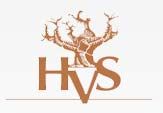 Finally, A Good Laugh Chris Erskine writing in a recent edition of the Los Angeles Times, notes that his wife worries that his lowbrow understanding of wines will one day get them evicted from California for not being cool enough. In particular, he said, “She objects to me intentionally looking at wine lists upside down, then sniffing to the waiter, ‘Never heard of any of these.’” Another humorous quote comes from Rafa Ibarra of Mexico speaking about wine bloggers. “I don’t know in the USA, but here in Mexico we have a lot of wine bloggers ass kissers that only want a free glass of wine and a picture with the winemaker of the moment, like a rock star. We call them enorockstars and enogroupies. It’s sad, but it’s so true.”
Vintner’s Night Before Christmas 2011
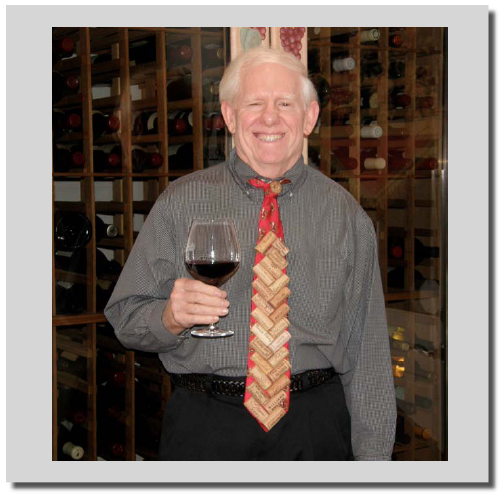
There was little sun Total production was Down by a ton
Best Wishes, Happy Holidays, and Sweet Pinot Dreams Prince |